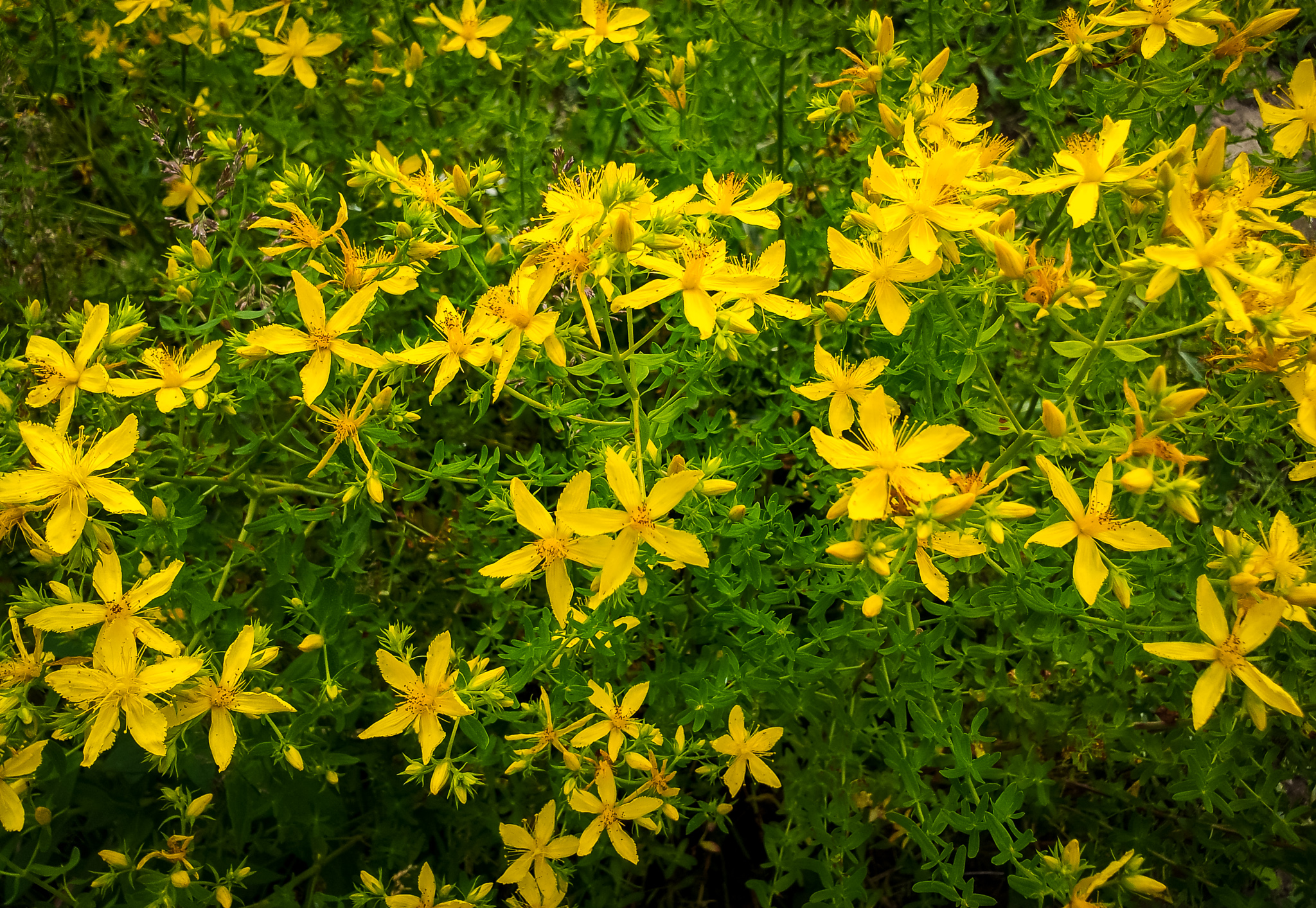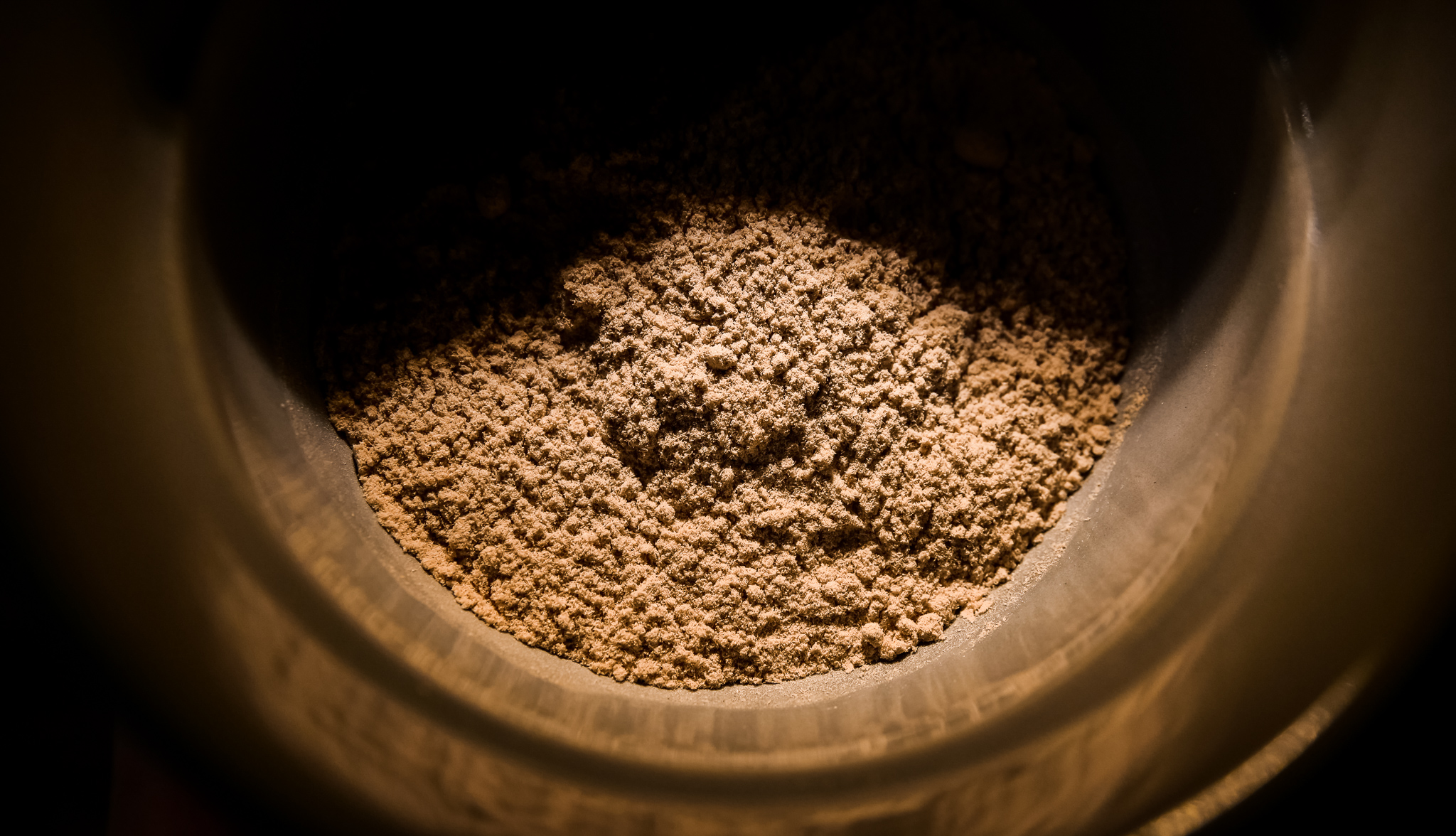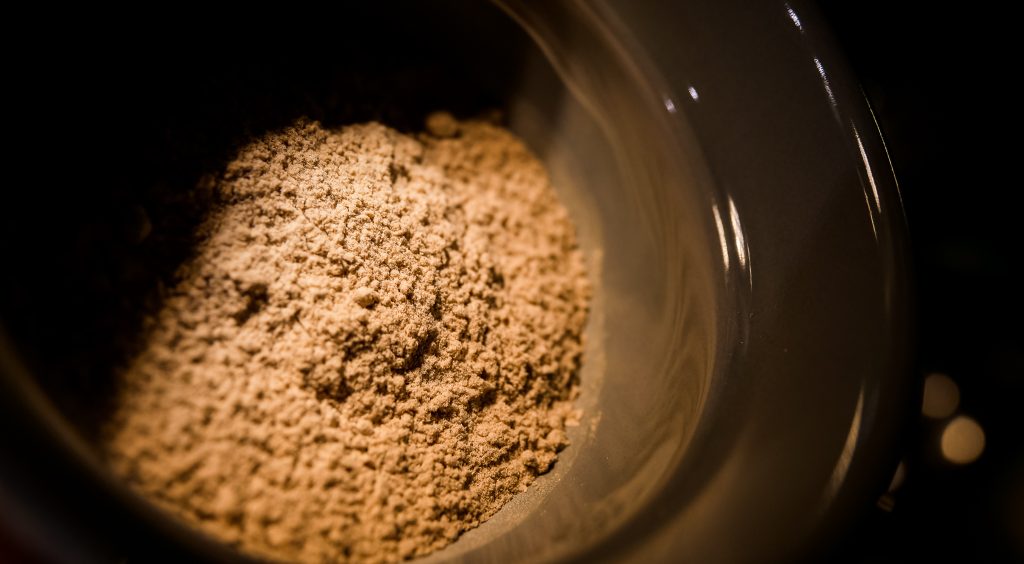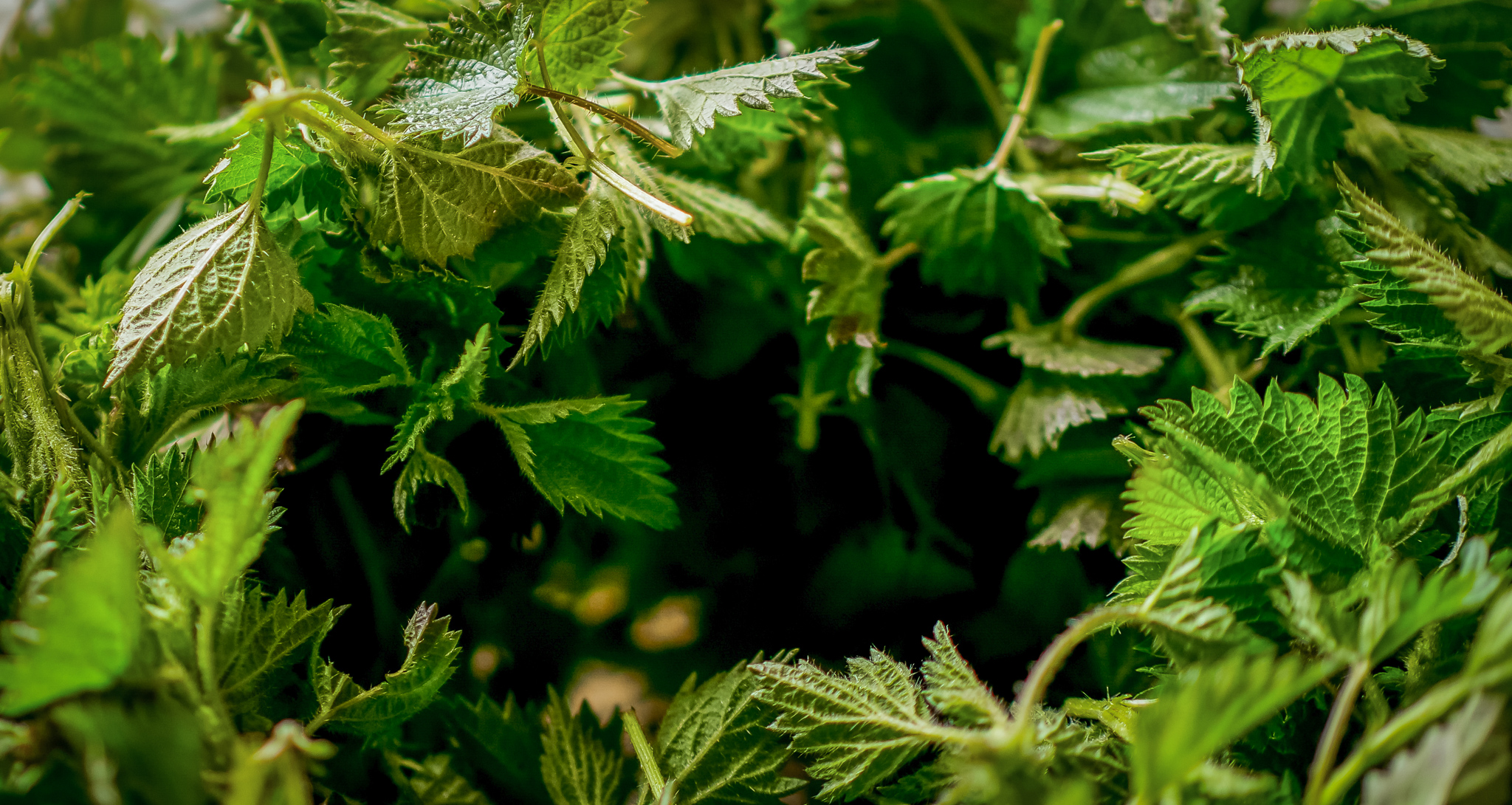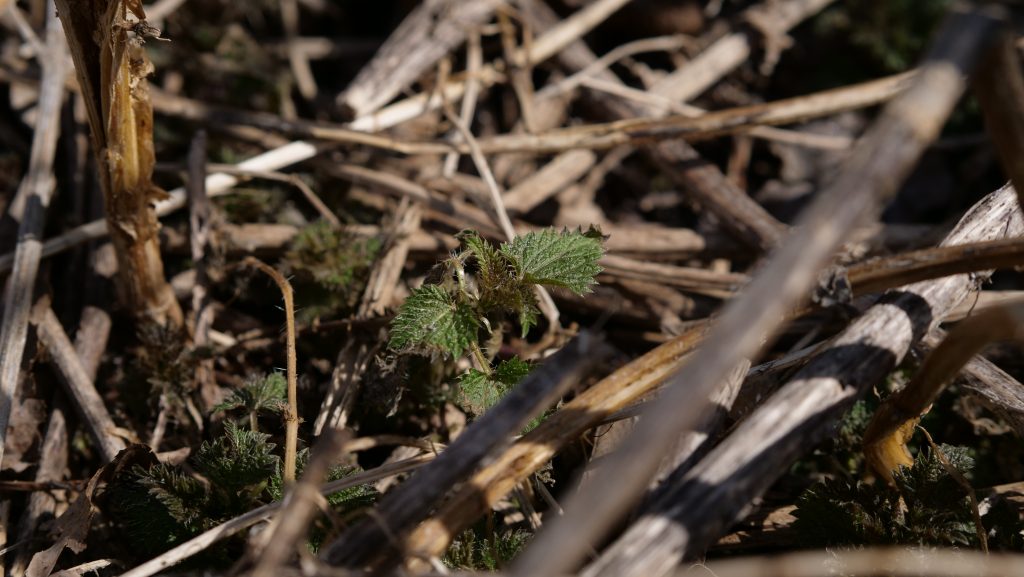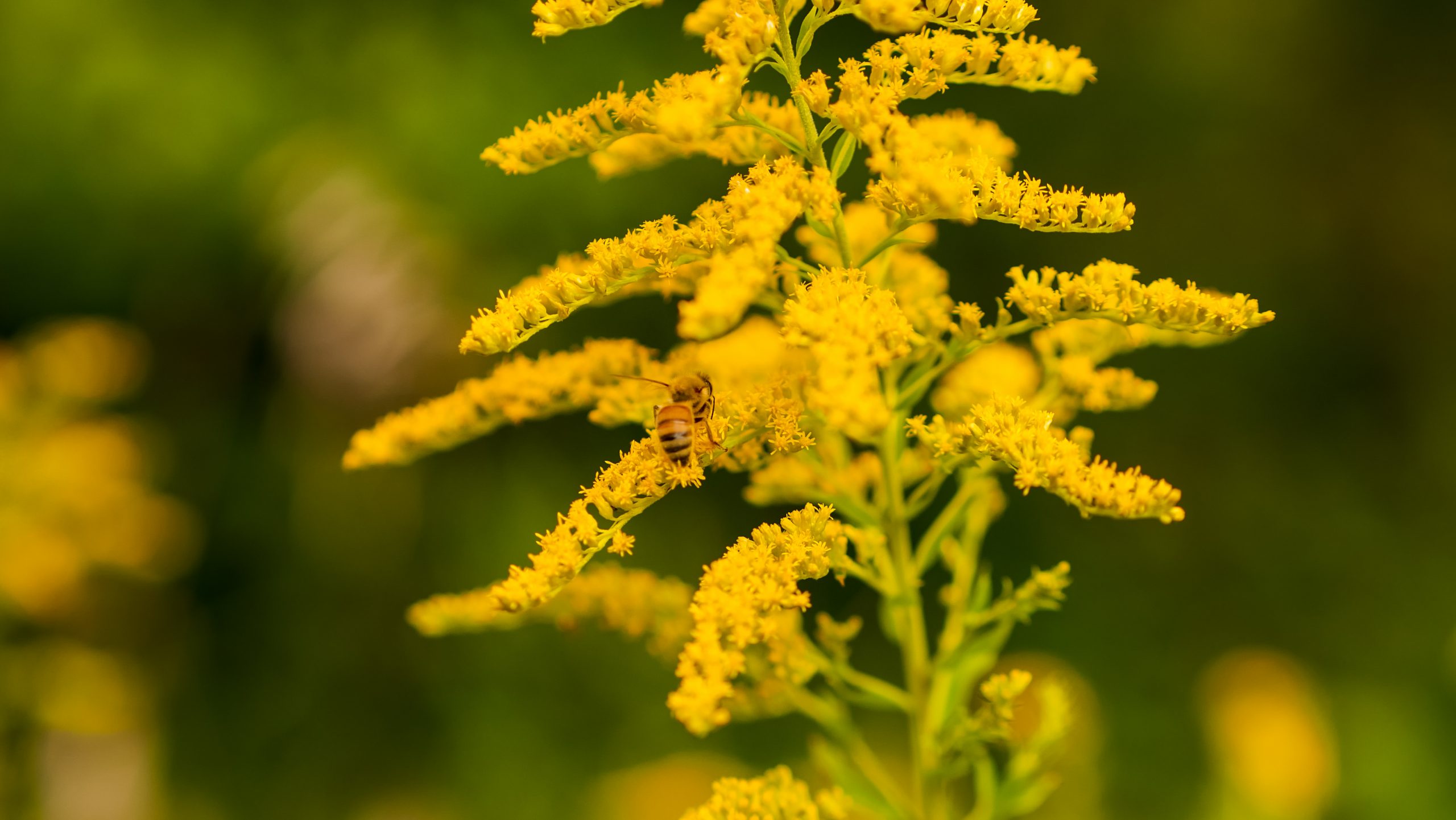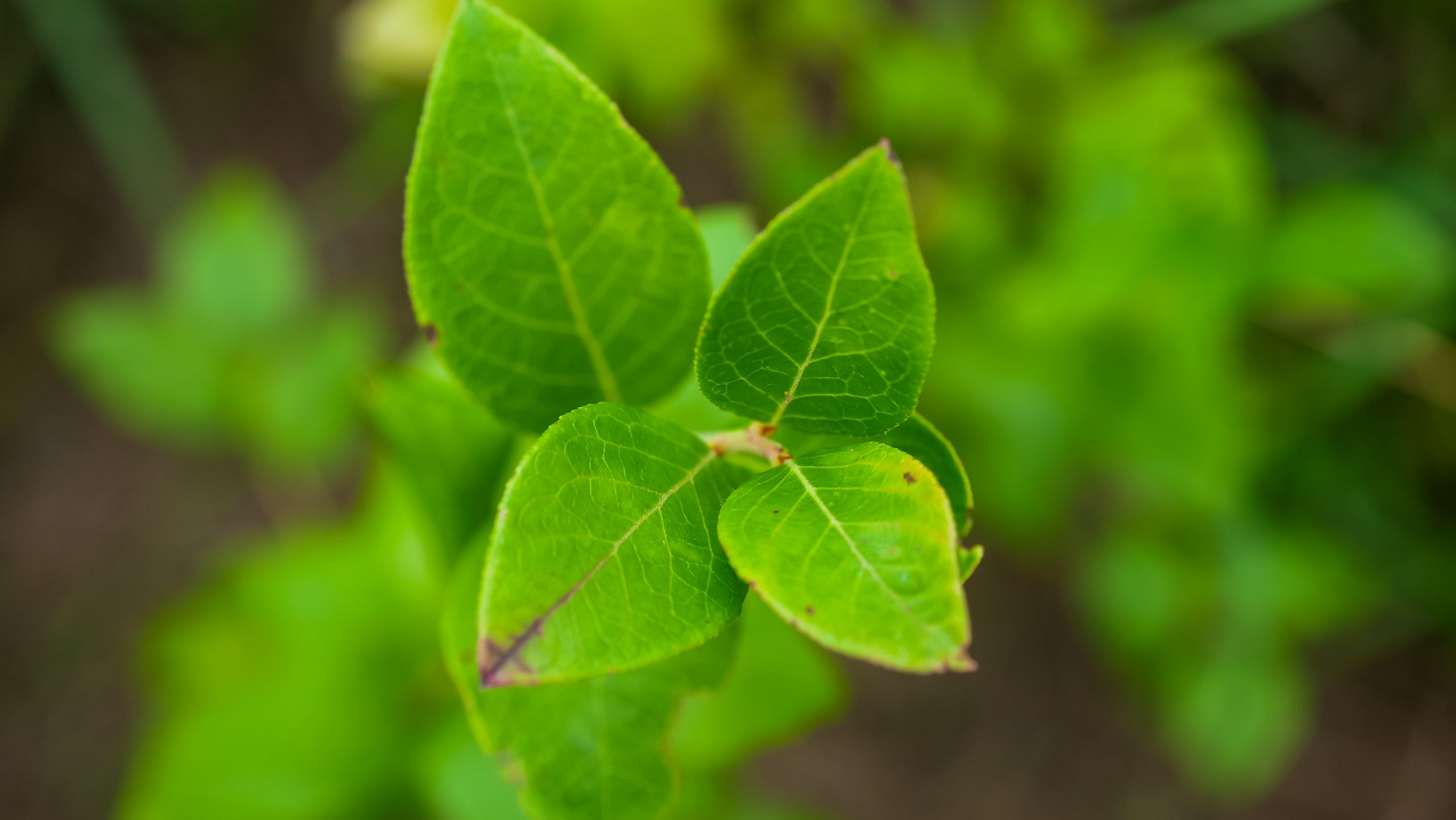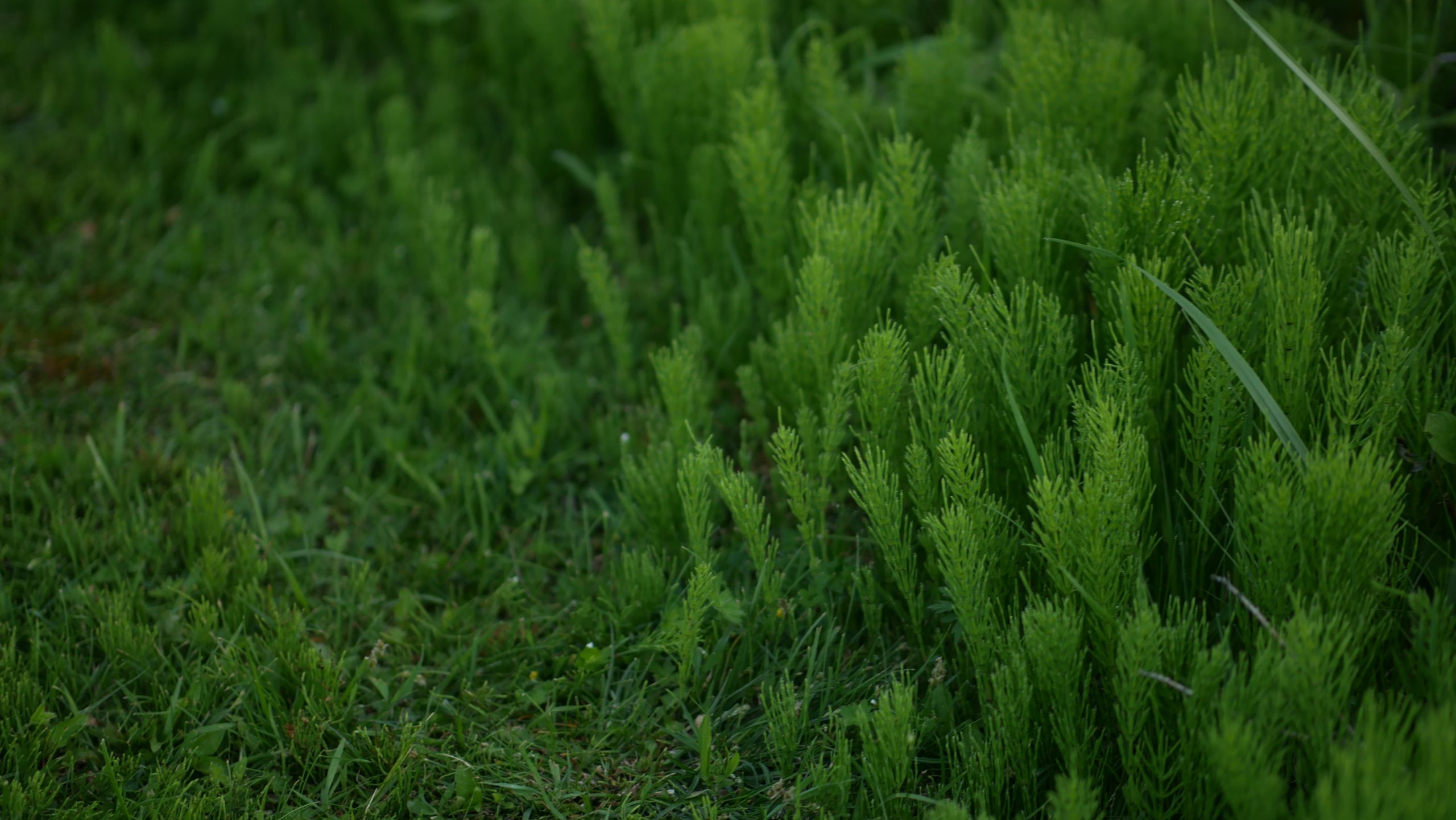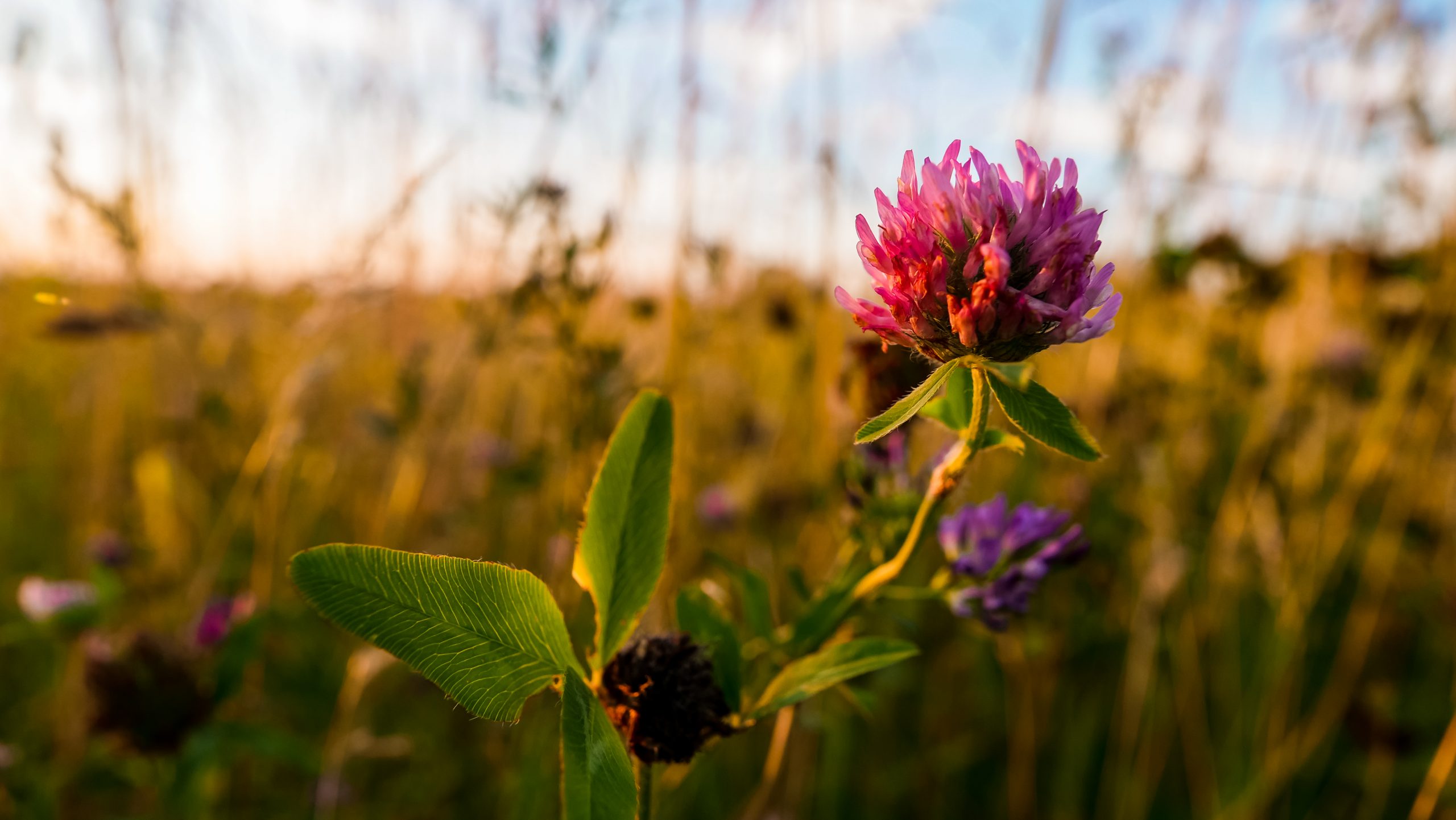Hot Chiles Bite Winter Back
Chile Pepper Medicine Turns Up the Heat
While on the quest for the shortest route to the East, Spanish navigators discovered the hot and fiery chile pepper. Abundant and adored by Caribbean natives, the conquistadors called it pimiento, the Spanish word for pepper.
Capsaicinoids are the naturally occurring compounds that give chile peppers pungency and heat. Every type of pepper has a unique taste – from slightly floral, fruity, sweet, and spicy to pungent – and each type has a heat rating that is based on the kind and intensity of the capsaicin it contains. For example, peppers that contain only nordihydrocapsaicin (NDHC) will present a mellow, warming effect that recedes quickly and lingers briefly at the front of the mouth. In contrast, the explosive heat and pungency of pomodihydrocapsaicin (HDHC) produces a strong numbing, burning sensation in the throat and back of the tongue that is more intense and lasts longer.
Chile heads (lovers of hot peppers) have long known that the hotter the chile pepper (and the more capsaicin it contains), the greater will be the endorphin rush they experience. Endorphins are produced by the pituitary gland and the hypothalamus – when released they cause a positive feeling in the body, similar to that of morphine. By triggering endorphins, capsaicins work as natural painkillers along with boosting memory function.

How to Gauge the Heat
Want to eat more chiles but are afraid of their blazing bite? I have two tips for helping you enjoy the incredible benefits of chiles.
First, get familiar with the Scoville Heat Unit (SHU) system of measuring the heat in chile peppers. The Scoville Scale is a standard measurement of the concentration of capsaicin (the constituent that causes the skin and mouth to tingle or burn) in every type of pepper and assigns it a number from 0 to 5 million.
Secondly, start cooking with peppers that are low on the Scoville scale and begin to work your way towards a higher rated pepper. Sweet bell pepper types rate 0 to 1000 Scoville Units, which means that they are delicious (red bell peppers are sweeter than green), with no discernable burning, but are not high in capsaicin. Hungarian paprika is only slightly hotter, with 1,500 units, but it imparts an apple note that is perfect for stew and goulash dishes, or in vegetable stir-fries. Poblano chiles and New Mexican types move up the scale to 7,000 SHU and are roasted or stuffed and baked for a mildly hot experience that dissipates quickly.
My goal, when I began to grow, buy, and cook with chile peppers was to become comfortable eating cayenne peppers, which flare from 30,000 to 50,000 SHU. This is a reasonable goal because we enjoy significant health benefits from adding one fresh (or dried) cayenne pepper to smoothies, soups, stews, stir-fries, or other dishes at least three times per week.
I’m happy to say that it didn’t take long before I was sizzling my way up to Habanero type peppers, which register between 80,000 and 150,000 SHU. Then my friends at Shady Acres Herb farm in Minnesota sent me some Bhut Joloka (aka Ghost) chiles that they had grown. Although Carolina Reaper chiles register higher in SHU (1,600,000 to 2,200,000 SHU), Ghost chiles are still considered to be incendiary, combusting at 855,000 to 2,199,999 SHU. I dried my cache of Ghost red hots and sometimes, when I am feeling adventurous, I slip on a pair of disposable gloves, snip off a quarter-inch piece of that phantom pepper and dice it into teeny granules which then get added to a chowder or curry dish. It never fails to deliver the famous chile-rush.
Health Benefits of Cayenne
Being exceptionally high in vitamin A, which acts as an antioxidant to help fight aging and cell damage, cayenne peppers, and all others above or below them on the Scoville Heat scale, deliver an incredible array of healing gifts. Buy or grow them and use fresh, or dry and crumble them into all kinds of dishes.
Here is what you can ignite once you begin to enjoy the cayenne conflagration:
- Anti-inflammatory action – reduces the pain and swelling of arthritis. Cayenne cream or salve is applied topically to treat arthritis and muscle pain
- Lowers cholesterol – and triglyceride levels for heart health
- Fights bacteria and viruses – with its high vitamin C content
- Increases circulation – by improving blood flow and stimulating sweating (an important process of detoxification). A tea made of warm water, lemon juice, and cayenne pepper is an excellent morning beverage for total body health
- Anti-fungal properties – soak feet in warm water with one tablespoon powdered cayenne pepper to help alleviate athlete’s foot
- Aids digestion – capsaicin stimulates the digestive tract and may give relief to people suffering from peptic ulcers by stimulating blood flow that nourishes the gastric mucosal membrane
- Helps relieve allergies – and acts as a decongestant by stimulating the release of mucus from respiratory passages
- Reduces blood clots – and can be used as a first response for wounds to stop bleeding
How about you? What varieties are you eating or using to make medicine?
Watch for my next post, Cooking with Cayenne. Meantime, here are some recipes that will warm and soothe:
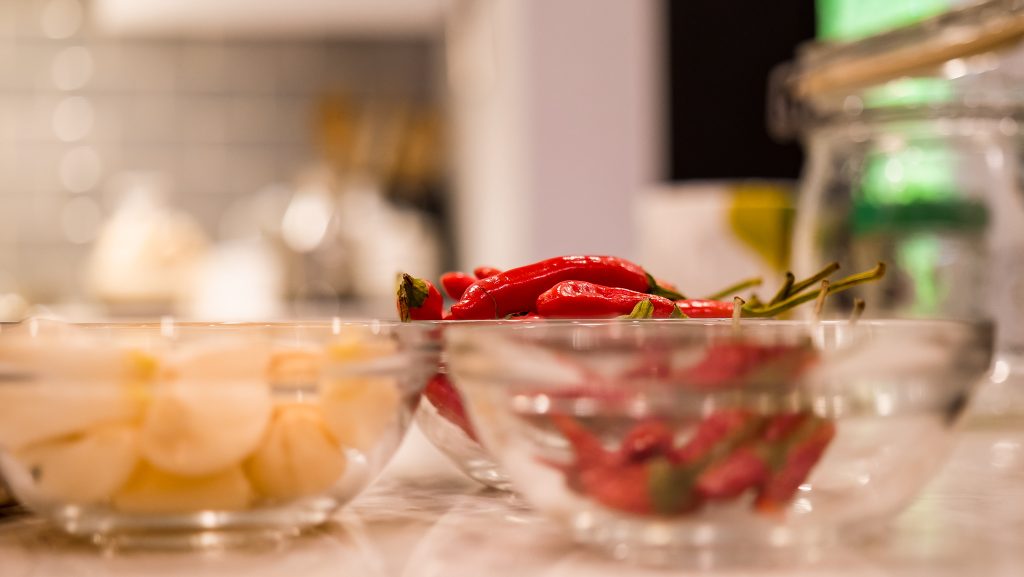
Harissa
A key flavouring and condiment in Middle Eastern and North African cuisine, Harissa is never far from a Moroccan, Libyan, Algerian, Turkish, or Tunisian table. In fact, it is the go-to seasoning for many cooks in the region. Often it is added to soup, stew and curry dishes or tagines, used with meatballs, or rubbed into kebabs and other meats before grilling. The main ingredient is cayenne (or other hot chile peppers) and while it is easy to make from fresh or dried hot chiles, it is also widely available in cans or tubes, or freshly prepared in tubs in Middle Eastern or North African markets.
Dairy products (in particular yogurt), and the starch in pastas and couscous, help to dial the heat down and so they are often paired with harissa and other hot chile dishes.
(Makes 1/2 cup)
Ingredients:
- 12 cayenne, serano, or jalapeno chile peppers, fresh or dried
- 3/4 cup boiled water
- 1 tablespoon cumin seeds
- 2 teaspoons coriander seeds
- 1 teaspoon fennel seeds
- 1 piece (2-inch) cinnamon, crushed
- 1/2 teaspoon fenugreek seeds, optional
- 2 cloves garlic
- 1/2 teaspoon sea salt
- 1/2 cup extra-virgin olive oil
Method:
Discard stems and seeds from the chiles. Using kitchen scissors, cut chiles crosswise into thin strips, letting them fall into a bowl. Pour water over top and soak for 30 minutes or until softened.
Meanwhile, in a small, heavy pan or spice wok, over medium heat, dry-fry cumin, coriander, fennel, cinnamon, and fenugreek seeds (optional) for three minutes, or until fragrant and light brown. Set aside to cool.
Using a small food processor or blender, chop the garlic with the salt. Drain chiles, discarding the soaking water (or reserving it for another use later). Add chiles to garlic and process until smooth. Add toasted spices and process to incorporate them into the mixture.
With the motor running, gradually drizzle in the oil through the opening in the lid, processing the mixture until the sauce is well blended to a consistency of mayonnaise.
Pat’s Cayenne Fire Cider
The name sounds daring, and the brew is ablaze with the energy of healing ingredients. This natural sinus, cold and ‘flu folk remedy has been home-brewed for eons by herbalists, naturalists, and anyone who has learned of its efficacy. Grated horseradish root, garlic, onion, ginger, and hot peppers are the main ingredients that are steeped in organic unpasteurized apple cider vinegar, but you can develop your own amounts and combinations. Before my horseradish plant grew large enough for me to actually dig the roots, I developed the following simple and very potent blend. Now I add the horseradish, but you can omit it if you can’t find fresh root.
See the Resources section for a link to herbalist Rosemary Gladstar’s Fire Cider method [2] and visit the Mountain Rose Blog [3] to read about this well-known herb supplier’s Fire Cider.
(Makes about 4 cups)
Ingredients:
- 25 whole fresh cayenne peppers
- 1 head garlic cloves, peeled and sliced
- 1 cup fresh ginger, grated
- 3 – 4 cups raw unfiltered apple cider vinegar
- Optional Ingredients
- 2 cups grated fresh horseradish
- 6 sprigs fresh rosemary, horehound, thyme, sage, parsley
- 2 onions, chopped
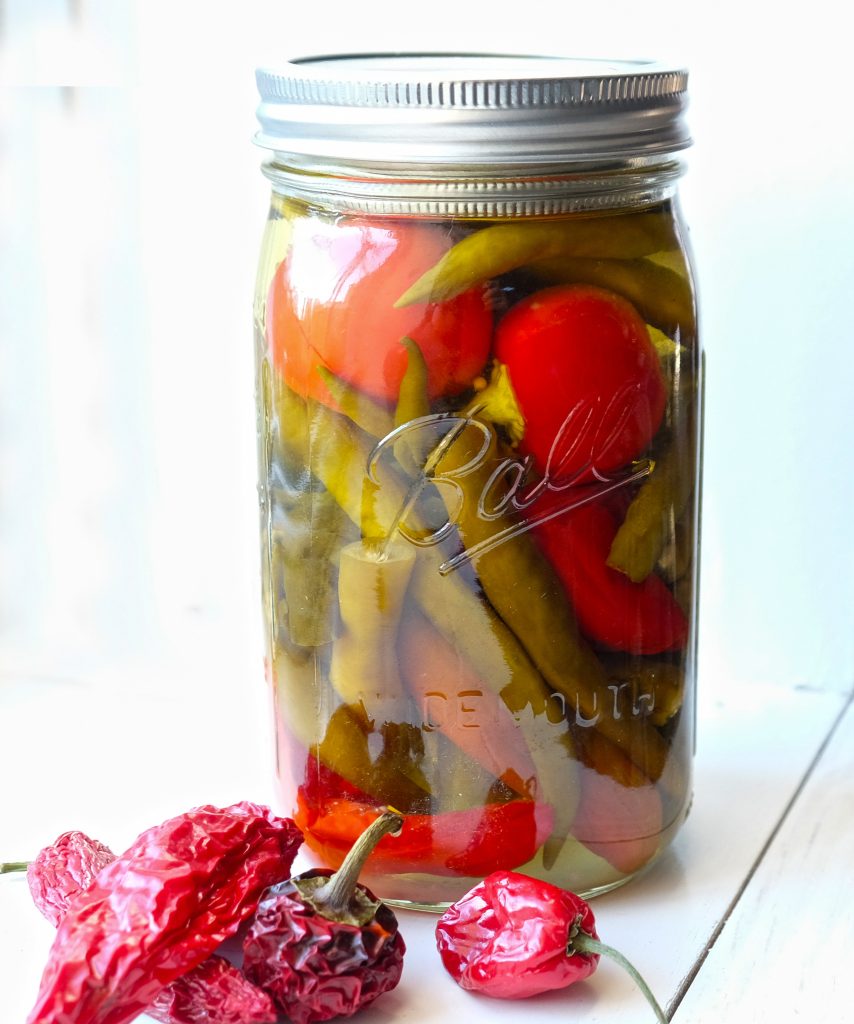
Method:
Clean and slit or halve the peppers. Loosely pack them into a one quart mason-style jar. Add garlic slices and ginger. Add horseradish and other optional ingredients, if using.
Fill the jar, covering the ingredients with vinegar, leaving a half-inch space.
Make sure the peppers are below the vinegar, and cap the jar with the 2-piece lid. Set aside in a cool, dark cupboard for a month or longer.
After steeping the ingredients, you can refrigerate the jar (although it isn’t required). If you don’t strain the vinegar, you can fish out, drain and use the chiles, garlic slices, and ginger in recipes until they are finished. Alternately, you can strain the vinegar and make syrup as follows.
To make a cough syrup: Strain the steeped vinegar into a 6-cup measuring cup, pressing on the solids to extract as much vinegar as possible. Discard the solids.
For every cup of strained vinegar, add 1/4 – 1/2 cup (to taste) liquid honey. Stir well or heat over low setting in a saucepan to melt and combine the honey. Pour into 1-cup jars, cap, label, and store in a cool, dark cupboard.
Serving suggestions for unsweetened steeped vinegar:
- Take one tablespoon of vinegar in a glass of warm water with one to two teaspoons of honey every morning for its tonic benefits.
- Substituting steeped vinegar in recipes that call for regular vinegar (salad dressing, dips, spreads, sauces, and other condiments) will infuse them with the healing benefits of Fire Cider.
- Cough Syrup: Take one tablespoon at the first sign of a cold and repeat every two to three hours until symptoms subside.
Resources
[1] Tucker, Art and Thomas De Baggio, The Encyclopedia of Herbs. Portland, OR: Timber Press, 2009
[2] Rosemary Gladstar, video of her Fire Cider method
Pat Crocker cultivates cayenne and turns up the heat in recipes. Her newest book, The Herbalist’s Kitchen is available on her website and at all major bookstores. Photographer, lecturer, and author of several award-winning books, including Coconut 24/7, Preserving, The Vegan Cook’s Bible, The Vegetarian Cook’s Bible, The Healing Herbs Cookbook, The Juicing Bible, and The Smoothies Bible, Pat would love to hear from you about your personal adventures with herbs. www.patcrocker.com
Blog photos provided by Pat Crocker
Header photo provided by Serena Mor
Talking About St. John’s Wort
A Herb of Meaning
As the days grow shorter and colder and the embrace of the night deepens, some of us may find that our inner sun is also waning. St. John’s Wort (Hypericum perforatum), which Matthew Wood has held up as perhaps the “archetypal healing herb” and Father Sebastian Kneipp has called the “perfume of God” and the “flower of the Fairies”, can help some of us navigate the states of all pervading darkness which take hold as we approach the Winter Solstice and the rebirth of the light.
In the symbolic language of Alchemy, the metamorphosis of a black bird into a white bird stands for the albedo, or whitening, process – a transformational movement of the psyche out of “its dark and depressive leadened state into a reflective sublimation that lightens the soul and is thought to bring a greater sense of consciousness and freedom. It is a kind of purification process and catalyzes psychic development” (Stanton Marlan, ‘The Black Sun’).
The Rhythmic System
While holistic herbal medicine does not simply prescribe St. John’s Wort for unspecified “depression” but always rather searches for the root causes underlying such a state of body and soul, I do see the “primary yellow flowers” of St. John’s Wort, as Rudolf Steiner described them, as a potential catalyst for this “whitening” process. For Steiner, Hypericum works to combat the malnutrition that stems from an overburdening of the organs of the rhythmic system – “There is the rhythm of the breath, the rhythm of the circulation, the rhythm manifested in sleeping and waking, and countless other rhythmic processes.” St. John’s Wort helps to carry the anabolic processes into the sphere of the nerves and senses and to aid the astral body’s inner mobility. The astral body is linked to the Manipura or solar plexus chakra, and Hypericum is an important remedy for treating conditions of the enteric brain or neural gut.
The Star and Sun
In the words of Julia Graves: “Flowers that shape tufts such as St. John’s Wort (a star with a tuft) point to nerve endings and sensitivity. St. John’s Wort is one of the finest nervines available. All of its starry, sun-yellow flowers look up; they facilitate the prana flowing in through the crown” (Julia Graves, ‘The Language of Plants’).
One may do well to imbibe in the herbal sunshine that St. John’s Wort offers when, as Hölderlin has it in his novel Hyperíōn, it is necessary to “call on Fate to give me back my soul.” Hypericum is a herb of spiritual and emotional protection, as is attested by a traditional use of the oil noted by Deborah Frances: “Recognizing that women are more sensitive and open during menses, women in traditional cultures in Europe painted their labia’s with an oil of Hypericum for protection during moontime.” One need only look at the flowers of St. John’s Wort, with their “golden five-petalled blooms radiating like small sun-wheels around a shower of bobbing stamens” (Susanne Fischer-Rizzi, ‘Medicine of the Earth’), to realize the magnanimous beneficence of this remedy. Fischer-Rizzi continues: “our forbearers saw in these flowers the captured power of the sun, each five-pointed star a sign of the benevolent powers. Ancient druids saw a resemblance to their sacred pentagram while Christians felt it symbolized the five stigmata of Christ.”
Lastly, let us note that the first part of the Latin binomial Hypericum perforatum is a derivation of the name of pre-Olympia God of the Sun; Hyperíōn, which literally means “The High-One.” That the yellow flowers of St. John’s Wort turn blood red when placed into menstruum and processed as a tincture or oil reminds us of the life giving power of the Sun, the Sun which gives without receiving.
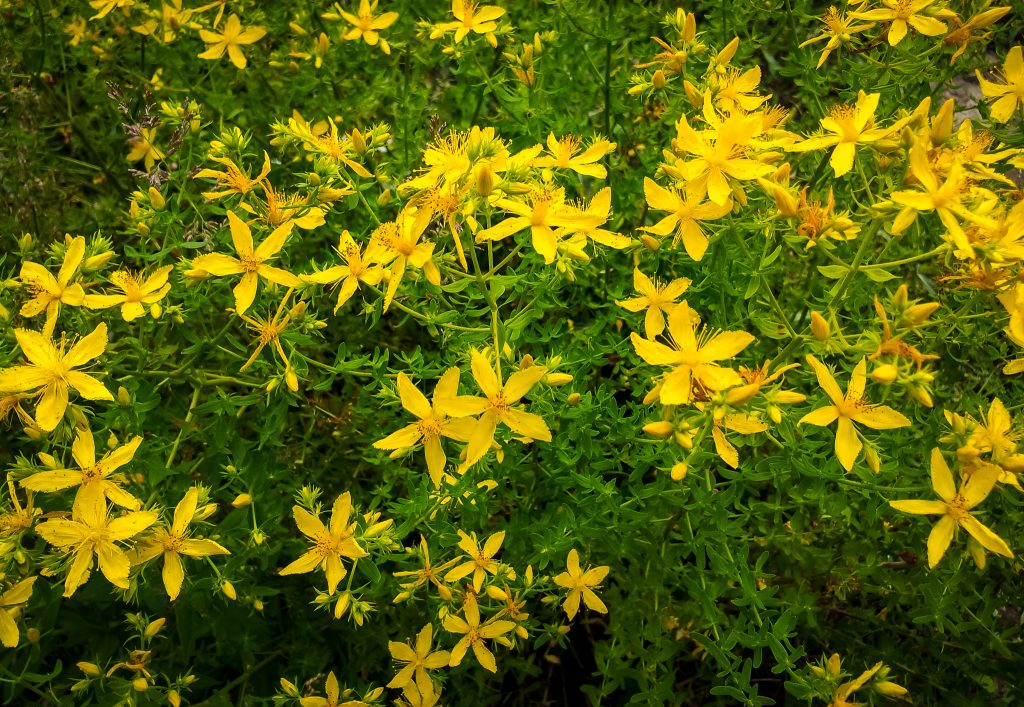
Photo provided by Nick Faunus
Herbal Tooth and Gum Powder: Oral Hygiene & Herbal Medicine
The Importance of Oral Health
It is said in many holistic healing traditions that all disease begins in the gut. But it’s important not to forget that the entire digestive process, and the beginning of our GI tract, starts in the mouth. A healthy mouth is essential for maintaining optimal immune system function, which becomes quite clear when we consider that a very significant part of the immune system resides in the digestive tract. Just as is the case with the gut microbiome, the microbiome of the mouth needs to be well cared for – the healthy bacteria need to be allowed to flourish. The condition of the mouth, gums, tongue, and teeth reflect many things about the health of the whole body. Rudolf Steiner went so far as to say that, “the teeth are the sum of the world mysteries.” Herbal tooth and gum powders are an excellent way to help care for the mouth. This particular blend can do wonders when it comes to weak tooth enamel, preventing (and, as per my own clinical experience, even reversing) cavities, tooth and gum sensitivity, soreness and pain.
The herbs in this formula have a long and continued history of use in herbal medicine, though since the advent of modern dentistry, are no longer quite as esteemed as they once were for their ability to keep the mouth, teeth and gums in optimal shape. Perhaps most notably from a historical perspective is the bark of the White Oak tree (Quercus alba). The astringing inner bark of this mighty tree contains tannins, saponins, and minerals (including calcium) – all of which, when properly balanced (i.e. found in the form of a whole herb, as nature intended), are greatly beneficial not only for the teeth, but also for the tendons that attach the teeth to the jaw. Looking back at our herbal literature, one can find many references to the use of Oak bark for gum disease, cavities, loose and brittle teeth, sensitive, sore and bleeding gums, foul breath, canker sores and ulcerations of the mouth.
Tooth and Gum Powder Recipe
Combine equal parts of the following finely powdered herbs:
- Horsetail
- Peppermint
- Licorice
- White Oak Bark
- Cloves
- Prickly Ash Bark
- Bayberry Bark
- Slippery Elm Bark
- Neem Bark
Application
Once finished, use this powder as you would any tooth paste (it can also be applied to any problematic spots in the mouth and let sit).
Cloves, Peppermint and Licorice, which can help to prevent the accumulation of biofilms – including plaque – on the teeth and gums, are strongly flavoured herbs and may be left out according to individual preferences. Many of the herbs in this formula exhibit broad spectrum antimicrobial activity, and leaving one or two of them out will not significantly affect the efficacy of the product.
Tongue Cleaning
In addition to the use of a herbal tooth and gum powder, one thing that I recommend to nearly all of my patients is tongue cleaning (preferably with a metal tongue scraper) – a practice which is considered to be of the utmost importance in the maintenance of one’s oral hygiene in the Ayurvedic tradition. As Karta Purkh Singh Khalsa and Michael Tierra explain in ‘The Way of Ayurvedic Herbs’: “Cleaning the tongue is a critical part of maintaining oral health. Ayurveda, in particular, emphasizes this daily practice. Brush your tongue while brushing your teeth, or use a tongue scraper. Tongue cleaning reduces bad breath, and helps to prevent plaque.”
Try incorporating herbal tooth powders into your daily routine. Please feel free to let us know about your experiences or if you have any recipes of your own.
Herbal Actions: Diaphoretics
Herbal Actions
What is a “herbal action”?
When we speak about the action(s) of a certain plant, we are referring to one or more effects a plant can have on our body. Often these actions are explained in two or three words; however, herbal actions are so much more than that! Since plants are wonderful complex beings, they also have several actions. Most herbs can compliment their action(s) in combination with another herb, basically showing off their best side with the support of a “good friend”. Sometimes they work great on their own, but most of the times, they excel with a good buddy on their side. Think- Teamwork!
Diaphoretics
The time of the year has come where many of us start to layer up again. Our hands and feet feel constantly cold, and the two pairs of socks we are wearing don’t seem to do anything. Additionally, our hands are freezing and all we wish for is a hot water bottle attached right to our bodies, tied down tightly with a warm woolly shawl. Believe me, I know what I am talking about…
Perhaps you think, this is not me! Despite the cooler temperatures outside, you just can’t seem to escape the heat. Just the thought of a hot water bottle is making you perspirate…
In this blog, let’s talk about diaphoretics and how they are not only helpful to both the extreme cold and the extreme hot of us, but also, how they can:
- Support the skin in its role as organ of elimination
- Stimulate outward circulation
- Relax tightly closed pores
- Stimulate the immune response and support the bodies natural fever response
Diaphoretics and the Skin
If you have a close look at your skin, you can see that the surface of it appears to be like a tiny little mosaic – not completely smooth like glass, but uncountable small sections with hair follicles and pores. Sometimes, the surface can look quite rough, with many small eruptions that can cause a certain area to develop a rash. This could be a heat rash, caused by sweat that is trapped in the skin or any other superficial rash. With any skin eruption, it is important to source out the root cause and treat it as a whole, as often times it can be a sign of insufficiently working organs of elimination. diaphoretics, however, are a great complimentary way of supporting our skin in healing a rash, while addressing the root cause altogether simultaneously.
If a rash is associated with tightly closed pores, we can help opening them up by using a stimulating and relaxant diaphoretic. Using some gentle alteratives in combination with Diaphoretics, is always a good idea.
Fevers and Stimulating the Immune Response
Some of you might be familiar with using diaphoretics during a fever. Starting at the first sign of a cold or flu, start drinking a hot tea with a diaphoretic blend including herbs such as Elderflowers, Linden flowers, Catnip and Peppermint. Let me put some special emphasis on the heat, as only hot liquids can act as diaphoretics. Many cold diaphoretic herbs will act more as a diuretic, which enhance the drainage of tissue fluid and increase urination.
By exciting our sweat glands, our metabolic activity is stimulated which at the same time, is alerting our immune system to ramp up. Through our skin, toxins can be removed, which can indirectly lower a fever.
Not only can it help to ease the signs and symptoms, but it can also help to drive out a fever. A fever is the bodies natural response to dealing with pathogens. It is important to keep a close eye on the temperature, as a out of hand fever can be quite detrimental. In most cases however, our body is doing an excellent job of killing the pathogens all on their own. By using diaphoretics, we can help generate that heat, stimulate circulation and take the heat from the core of the body and bring it to the periphery. While promoting perspiration, it is incredibly important to stay properly hydrated. Drinking lots and lots of hot tea, water and strengthening bone broth are of upmost importance.
Stimulating and Relaxing Diaphoretics
In general, all diaphoretics promote perspiration by opening up the pores of the skin, and even though it might seem we have to pick either of the two, stimulating and relaxing diaphoretics work best when used in conjunction.
- Stimulating diaphoretics act as a circulatory stimulant. By opening up the capillary beds, they help to bring up the heat up to the surface. For individuals with a cold constitution, this will help to circulate some heat to the periphery. For anyone experiencing hot flashes or are generally of a hotter constitution, it helps to bring the core heat that is stuck on the inside to the outer surface. This is why in most warm climate zones, people tend to enjoy their hot and spicy foods!
Examples of stimulating diaphoretics are: Zingiber officinalis (Ginger), Capsicum annuum (Cayenne) or Achillea millefolium (Yarrow).
- Relaxing diaphoretics help to loosen tight, tense tissues. If your pores are closed tightly, the skin is dry and tense and lacks proper hydration in the form of water and oil or if you just can’t get a good sweat, it might a great idea to add relaxing diaphoretics.
Examples of relaxing diaphoretics are: Tilia europea (Linden flowers), Sambucus nigra (Elder flowers) or Nepeta cataria (Catnip).
I hope this post gave you a little insight on diaphoretics and how they can interact with our body. This topic is covered much more in depth in the herbal course, which is currently developed and coming soon by our group of wonderful herbalists.
Resources:
Besides my own words, this write up features information from the following resources:
– Ursel Buehring Praxis- Lehrbuch Heilpflanzenkunde – Grundlagen – Anwendung – Therapie. 4 ueberarbeitete Auflage. Karl F. Haug Verlag in MVS Medizinverlage Stuttgart GmbH & Co. KG’ 70469 Stuttgart, Germany. 2014. (Published in German language)
– Jim McDonald – Foundational Herbcraft – www.herbcradft.org – collected writings from www.PlantHealkerMagazine.com.
– Lisa Ganora – The action formula – PDF – 2015
– David Hoffmann – Medicinal Herbalism: The science and practice of herbal medicine. Healing Art Press, Rochester, Vermont 05767. 2003.
Nettle Seed
Nettle Seed
(Urtica dioica semen)
Etymology
- urtica from the Latin “urere” meaning to burn
- dioica from Latin for “two houses” – this refers to male and female flowers occurring on separate plants.
- Nettle from the Anglo-Saxon word “noedl” meaning “needle”.
In contemporary western herbal medicine, nettle seed is essentially an energizing trophorestorative for the kidneys. Some herbalists also refer to nettle seed as an adaptogen.
Historical Uses
Let’s begin with historical uses.
First Historical use of Nettle Seed:
Nettle seed was part of the feed given to horses that were much loved. It made their coats shiny and they appeared to have more vigor.
This is important because the coat of an animal, or the hair of a human, will tell you a lot about the health of the body from which it sprouts. Hair that lacks lustre and fullness, unless there is male pattern baldness (androgenic alopecia) which is hereditary, suggests the body lacks the nutrients it needs. The body will sacrifice the hair in order to conserve nutrients needed for more necessary functions. If malnutrition is prolonged, changes can also be seen on the nails and skin.
So, we know from those who fed their beloved horses nettle seeds had healthier animals with sustained vigor. We can hypothesize this is because of the nutrients in the seed.
Second Historical non-use of Nettle Seed
Monks during the middle ages, 500 CE to about 1500 CE, were forbidden to take nettle seeds. It was considered an aphrodisiac. They were given Vitex agnus castus seeds instead. This plant suppresses libido in men.
We now know that Nettle seeds awakens the sexual appetite in men. A vigorous sexual appetite suggests gusto for life. This suggests the Nettle seed in some way nourishes the endocrine system. The endocrine system is responsible for survival of the species. It does this by releasing hormones that govern of many of life’s survival actions including inflammation and fever as well as fight, flight and freeze and sex. Sex being essential for the survival of the species.
Nettle Seed, as do most seeds, are high in essential fatty acids. These oils are necessary for a healthy functioning endocrine system which includes both sexual and immune health.
Third Historical use of Nettle Seed
Culpepper, an English herbalist from in the mid 1600s, had many uses for Nettle Seed. From Culpepper’s Complete Herbal…..
The seed provokes urine, and expels the gravel and stone in the reins or bladder, often proved to be effectual in many that have taken it. The same kills the worms in children, eases pains in the sides, and dissolves the windiness in the spleen, as also in the body, although others think it only powerful to provoke venery… The seed being drank, is a remedy against the stinging of venomous creatures, the biting of mad dogs, the poisonous qualities of Hemlock, Henbane, Nightshade, Mandrake, or other such like herbs that stupify or dull the senses; as also the lethargy, especially to use it outwardly, to rub the forehead or temples in the lethargy, and the places stung or bitten with beasts, with a little salt.
From Culpepper we learn about Nettle seed’s direct actions on the kidney. Remember contemporary herbalists now most commonly use it as a kidney trophorestorative. Culpepper tells us it removes kidney stones.
He also suggests it has anti-parasitic actions as well as anti-viral actions. Rabies is a viral infection. This is very interesting to me as I see a lot of infections in my practice and we are currently living with a virus that is changing all our lives.
What Else Can Nettles do for Us?
Constituents of Nettle – not necessarily the seed as most research is done on the leaf – is demonstrating anti-viral activity. For further reading, you can check out this link [here].
One of the primary finding’s researchers noticed when offering nettles as medicine, is the lack of weight loss and vitality when mice were injected with a killing virus. This refers back to those who love horses already knew: Nettles are a super food! And Nettle seed is a super, super food!
The Kidney
Herbal Medicine is the relationship between plants and the body/mind complex. To understand a plant’s medicine, one needs some understanding of the organ or system that the plant effects.
The kidneys are mentioned 5 times in the Hebrew Bible as the organ as God examines to pass judgement on the soul. It is said, Abraham learned the laws of God from dreams offered by his kidneys at night.
“I will bless the Lord, who has given me counsel; my reins also instruct me in the night seasons” (Psalms 16:7).
The ancient Jewish sacred text the Talmudic corpus teaches that one kidney offers good advice, while the other offers bad advice.
In Traditional Chinese Medicine, it is often said that the kidney is where fear resides in the body. The word for fear in Mandarin is Haipa. Haipa is broken into two pictograms; “Hai” which is translated as harm, evil, kill and calamity, and “Pa” which translates into afraid, fear and dread.
Translations of Haipa are; to be scared, to dread, to lose courage, to be unable to endure and to worry.
I find these considerations of the “emotionality” (for lack of better word) of the kidney’s important when we are speaking of Nettle Seed as a kidney trophorestorive. If we consider these ancient understanding of kidneys – a kidney trophorestorative is a plant that restores the courage, resiliency and the power to stand in our creative goodness.
This brings us to the adoptogenic effect of a kidney restorative. Adaptogenic herbs act on the adrenal glands to moderate the body/mind’s response to stress.
Stress is such an overused word today that it has almost lost its significance. “We are all stressed out!” Think of stress as the loss of courage, coming from the French word for a “good heart.” When we lose the good heart of courage, we begin to worry. The worry spirals into fear and soon we are waking every morning with dread in our bellies.
Nettle seed restores the courage to the heart by easing the worry from the kidneys.
A More Physiological Understanding of the Kidney.
The kidney controls the tension or relaxation in the heart and all the blood vessels and therefore the delivery of blood carrying nutrients and oxygen to the rest of the body – including the brain. Relaxed, but not too relaxed, circulation means every cell in the body receives the nutrients it needs to be vibrant and healthy. Tension in the kidney has a influence on every cell in the body. Worry creates tension!
The kidney also filters blood. In a cadaver antonym class, squeeze a kidney and it’s like a sponge releasing fluid. The kidney filters the by-products of metabolism, particularly protein metabolism and maintains electrolyte balance. If the kidneys are hindered in their ability to filter the by-products of metabolism, the skin takes on the role. This is why people on dialysis often have the smell of urea coming from skin. Their skin is doing the work on the kidney (back to those horses).
Electrolytes balance the fluid levels in your blood plasma, interstitial tissue and within your cells. Electrolytes maintain the pH balance of your body and enable the contraction of your muscles including your heart and arteries and participate in transmission of nerve signals.
Your kidney’s actions touch every part of your body and can have a profound impact on your mental well being as well. When you take a kidney trophorestorative, you are supporting not just your kidneys but your whole body.
Signs and Symptoms That it’s Time to Take Nettle Seed
- Mid and low back ache when standing. It feels like fatigue in your back. (This, for me, is the key indication that Nettle seed is needed.)
- Dread and fatigue in the morning upon waking. This fatigue can pause once you up and getting on with your day, or it may remain if it has moved deeper into your beingness.
- Aching legs worse with cold.
- Water retention, swollen tongue.
- Low libido.
- Sighing.
When Not to Take Nettle Seed?
- When someone is completely depleted. Nettle seed carries a lot of energy. If someone does not have inner reserves, you may want to begin with Nettle leaf and as the person re-energizes introduce Nettle Seed.
Dosing
Start low and go slow. It is very invigorating and can interrupt a delicate sleep pattern if take too late in the day.
More recourses on Nettle Seed:
- https://www.researchgate.net/publication/242275567_Urtica_semen_reduces_serum_creatinine_levels – Johnathan Treasure’s research into Nettle Seed credited with awakening the current interest in the plant.
- http://ravensongseeds.com/blog-post/nettle-seed-season – This is a fantastic article with harvesting tips and recipes and much more.
- https://napiers.net/blogs/news/nettle-seed-uses – Some curious clinical applications of the Nettle seeds. One needs to check the resources though.
Goldenrod
Goldenrod
AKA: Solidago
Uses
- Used for kidney stones, urinary tract infections, bladder inflammation, digestive problems, colds and flu, sore throat, congestion, laryngitis, fatigue and surprisingly hay fever and allergies.
- Indigenous peoples boiled leaves and used them topically as an antiseptic and astringent for wound healing and relief from eczema, arthritis and rheumatism
A Little About Goldenrod
- This beautiful herb grows in plant colonies, some are 100 years old! Older, central plants may eventually die back, creating a ring, but usually colonies are too dense for other plants to invade. Surprisingly, Goldenrod has no allergens. It is not goldenrod that brings on fits of sneezing in the fall, but the inconspicuous ragweed that grows in the same conditions, the same area, and at the same time. The heavy sticky pollen of goldenrod is not wind-borne, because many different insects take over the task of its pollination.
Historically
- After the Boston Tea Party, when American colonists had dumped all the tea into Boston Harbor, they discovered they had lost their favorite beverage. Not to be deterred for very long, they found that an excellent tea could be made from the leaves of the North American goldenrod, and they named it Liberty Tea.
- The stiff stem of the plant was historically used as a divining rod, but that was only successful if used by the right person.
- Another belief is whenever golden rod grows near a house, its occupants will have good fortune. Still another holds that wherever goldenrod grows, there can be found buried treasure.
- There is also a legend about two little girls that were very close friends; one was golden blonde and the other was dark haired with beautiful blue eyes. They were afraid that when they grew up they might be parted from each other so they didn’t want to grow up. To solve their problem, the two little girls set out one day to visit the good witch who lived across the field far away. They came to the good witch after a long day of travel and told her of their wish to always be together. The little girls were never seen again, but whenever you see the golden yellow bloom of the goldenrod you will be sure to find the sweet blue aster always beside her.
The Story of the Haiti Naturopathic Clinic: An Interview with Julia Graves
Emergency Medicine and Disaster Relief in Haiti
Welcome to an interview with Julia Graves! This interview was conducted by Victor Cirone with photos used with permission from Julia.
This interview was conducted on May 27th, 2021, before the assassination of Haitian president Jovenel Moïse, and before the recent, devastating earthquake of August 18th. Julia is currently coordinating fundraising efforts for the earthquake victims and to help support the vital work that is carried out by the disaster relief clinic that is the focus of this interview. To find out more about how you can help, and for updates on the current situation in Haiti, please see the clinic website and subscribe to their newsletter: haitinaturalclinic.org
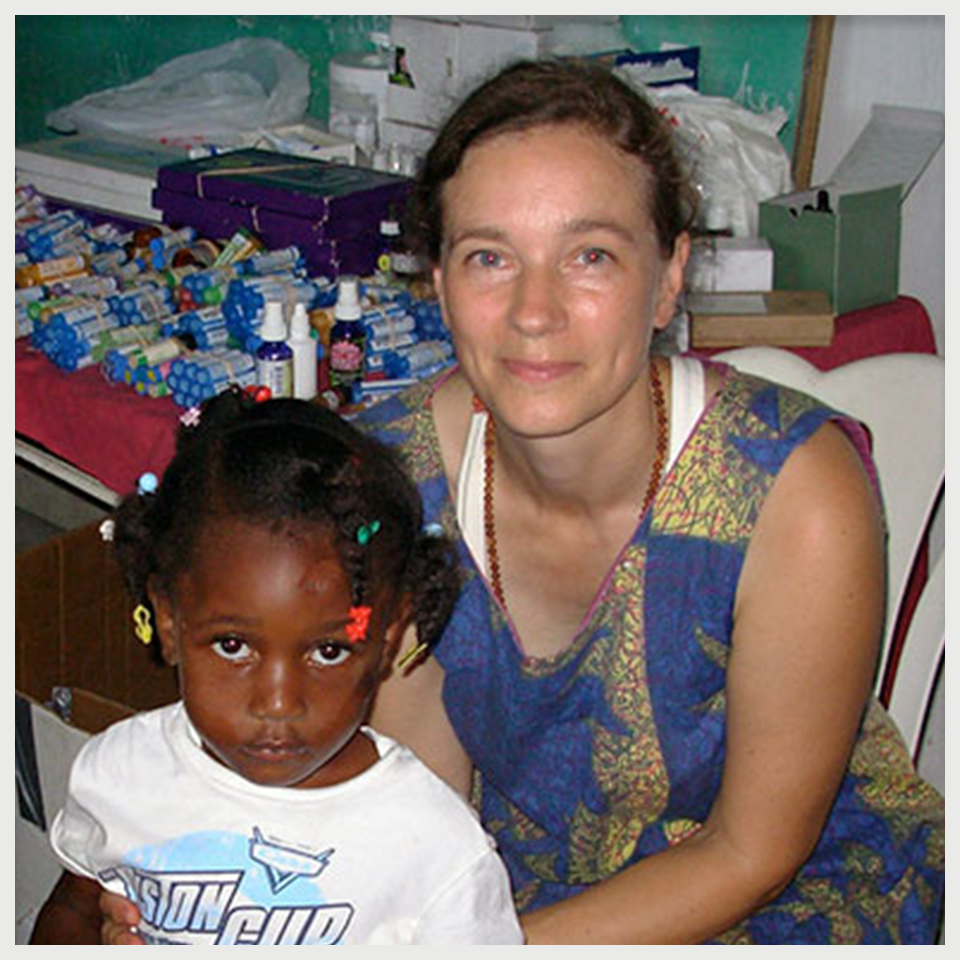
Victor: What can you tell us about the trajectory of your life and work, and specifically how you got to where you are working in Haiti?
Julia: The moment of us starting the clinic in Haiti is, in a way, the culmination of my life up until that point. I was raised by an herbalist mother and an orthopedic surgeon father, so I’ve worked between the paradigms of conventional medicine and plant healing. Then I trained four years of medical school and as a psychotherapist, and I always continued to work with plants and natural healing. I had at that point, when the great earthquake struck Haiti, at least 30 years of experience of working with herbs, flower essences, aromatherapy, and homeopathy. Because it was my partner’s [Jacquelin Jinpa Guiteau] home, and his father got injured in the earthquake, it became very compelling to go and help. If you remember, it was an underwater earthquake, so the epicenter was off the coast, under the ocean, about 3km out – Jinpa’s parents’ home was exactly 3km on the shore. His father fell and injured his shoulder, but we couldn’t send him any help, and we couldn’t go there because all flights had been stopped. As soon as the first airplanes were allowed back into Haiti, he went to just see the situation and said, ‘if I go I would like to help people who are in need of medical care, could you put something together for me as a first aid kit?’ Which is what I did. 48 hours later he called me and asked if I could join him immediately (I was in France) and bring $10000 in donated cash and two suitcases more full of natural medical supplies. 24 hours later I was in New York to pick up the cash and more than 2 suitcases worth of donated supplies, and in 48 hours I was in Haiti, in the rubble. And that’s how it all started.
I do want to add one thing: all of my experience went into a precise concept of the clinic. I had a very clear idea that homeopathy would be great: it’s tiny, it’s light, you can give one pellet per person, and so with a tiny amount you can treat the masses. If need be, you can succuss more, you can dilute and potentize more. Similarly with essential oils, you can do a lot with very little. Although I’m very much an herbalist, I was very clear that trying to stuff dried herbs into your suitcase, or bottles and bottles of tinctures is just not ideal for an emergency situation. So, based on my background, I clearly favored homeopathics and essential oils and that was the bulk of what I brought initially.
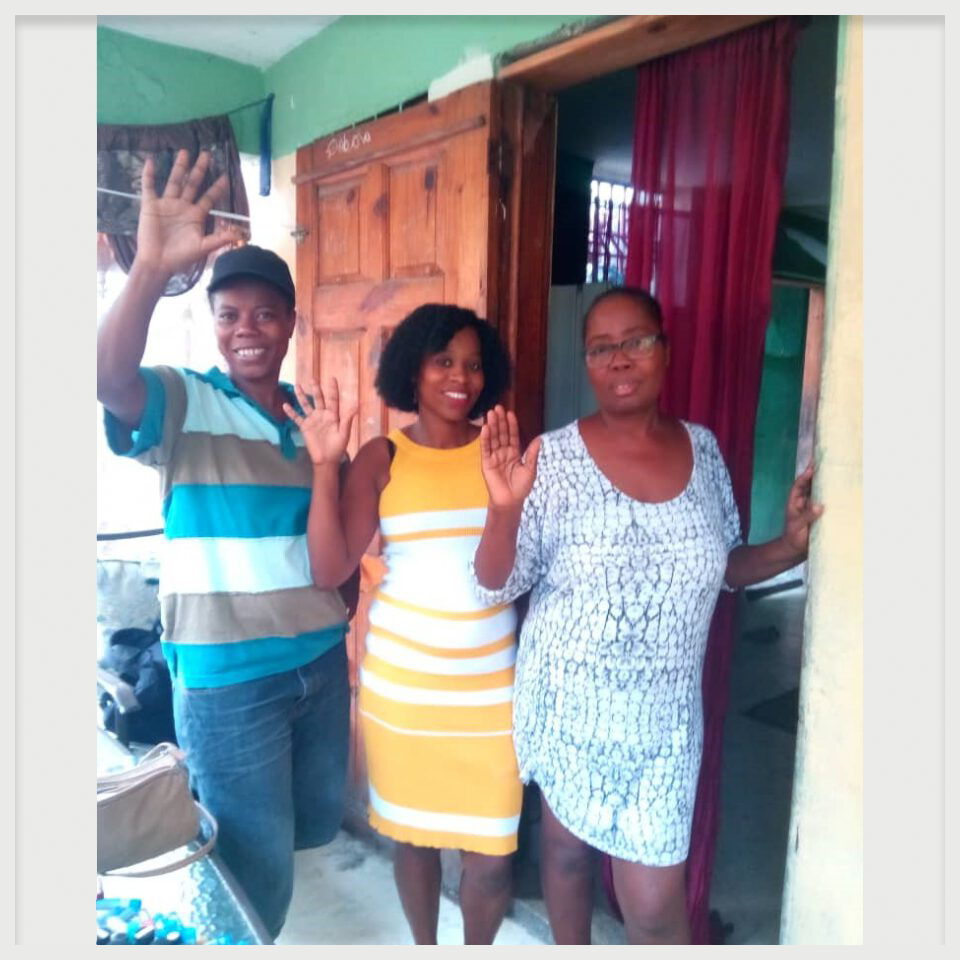
V: Most of the audience who will be reading this interview will have more of a background in herbal medicine than they will in homeopathy. At least in North America, there is still a fairly strong divide between herbal medicine and homeopathy. There are some herbalists that I’ve encountered who have even expressed suspicion or outright disdain for homeopathy, claiming that there’s no way it has any real efficacy, that it lacks scientific legitimacy, etc. Can you tell us more about the protocols that are used in the clinic and why homeopathy is so important to the work you do there, beyond how easy it is to transport homeopathic remedies and how cost effective they are?
J: Let me first talk a little about why I brought essential oils. First of all, we as herbalists quite rightfully assume that we can use the essential oil of chamomile in a similar way to chamomile tea or tincture. It is very easy to make that transition when you are faced with an emergency situation where you can’t put a lot into your suitcase, and so, take a variety of essential oils. The other thing is that essential oils are highly antiseptic – they kill everything, as it were: antibacterial, antiviral, antifungal, antiparasitic. Most essential oils are the first three, and some also end up being antiparasitic. When we reached Haiti, the streets were so cracked open, everything had fallen to pieces, and the stench in the air of the rotting bodies was just unfathomable. In such a situation, you want something that is very, very ‘anti-everything.’ On top of that, to purify the air from germs, you want to use essential oils. You can spritz them, you can leave them out, and you can literally disinfect the air around you in that way. It was very good for us as healers to be in a situation like that where we could handle substances that served to protect us from disease. We still got horrific diarrhea, but there wasn’t even anything close to clean water available at that point.
For me, I can understand that most herbalists cannot understand homeopathy. There’s an element of mystery to it. You can’t understand how it can possibly work. I trained very young in homeopathy, when I was 19. By the time I went to Haiti I had tons of experience using homeopathy in emergency situations. I had lived in India for 3 years where I trained at the Tibetan monastery that is next to the Dalai Lama’s palace in Dharamshala, and there is no medical care for the little boy monks there. So I was treating a lot of these boy monks and people in India who were in very desperate situations, including lots of animals and lots of babies, so I knew for sure that you don’t have to believe in homeopathy for it to work. I had treated people who can’t speak because they are babies, I treated animals, people who can’t speak the same language as me, who have no understanding of what I’m putting into their mouths, and I had seen incredible results in very poor hygiene type of environments. I had complete confidence, I had my baptism by fire, what the horse rider experiences when they fall off the horse for the first time – I had already been through that. At the point I came to Haiti nobody could have talked me into the idea that homeopathy is not effective. And I was already very experienced treating myself and others, so for me it was just a no brainer, especially when it comes to vulneraries, injury remedies, or things for acute and superficial issues such as disease from dirty water – diarrhea and vomiting – I had tons of experience treating that in India.
To take another common scenario we encountered in Haiti: being sick as a consequence of sleeping outside in the cold. When we got to Haiti it was March, the earthquake was in January, so everybody had been sleeping in the streets in February when it is quite cold, and we have this wonderful remedy in homeopathy called Aconite, which is also used in Chinese medicine to warm people up, for diseases from cold. There are wonderful homeopathic remedies from the Artemesia genus of plants, which are also used in herbalism, for the treatment of worms and parasites. In underdeveloped countries virtually all children have worms. We could discuss many other common scenarios and the relevance of homeopathic medicine in dealing with them. Based on my previous experience, I already knew what I was going to need and want. We had anticipated injuries, coughs and colds and the usual stuff such as malaria and yellow fever; but we hadn’t anticipated the mind-blowing amount of vaginal infections, which had nothing to do with the earthquake per se, but with poor hygiene and dirty water. And for that we then had to work out a treatment protocol.
Lastly, just to add one more reason explaining why the homeopathic approach was so great in this context, especially in the initial years, was to treat street children: You cannot give a homeless three year old who lives in the street anything herbal – a bottle will be lost almost immediately, they have zero access to potable water, let alone a fire or tea kettle so herbal teas are out, etc. I was incredibly grateful to have a reliable and powerful method where I could give the child one single dose right into their mouth and know it could cure whatever ill was at hand (worms, influenza, head trauma), with the higher potencies’ action lasting for weeks and months.1
V: I remember that in one of your previous newsletters, you talked about a traditional Haitian practitioner, a herbalist and bonesetter, and I remember that you said in that piece that the Haitian people were somewhat skeptical of working with him, that they didn’t believe that he had the healing abilities that he did. Can you talk about the attitude of the Haitian people when it comes to disease and healing generally, and about traditional Haitian healing practices in particular?
J: We literally had to start the clinic by putting a table and four chairs out. There was Jinpa on one side being one of the doctors, me on the other side being the other doctor, with a second chair for each of the patients. We immediately had 300 or more people a day, between 300 and 500. The most we could treat on a given day was 500. There was a lot of skepticism. People were desperate because there was no medical help at all available to them; you have to understand that the medical system in Haiti is such that when people can’t pay, there are zero medical services available to them. We were in the city of Port-au-Prince because the epicenter hit there. There are no wild plants there. In the Haitian countryside there is still traditional herbal medicine available. People were very skeptical of us because first of all they had very bad experiences with large organizations such as the Red Cross. There are two main things we heard over and over again: the first was that people didn’t want to stand in line and wait to be treated because, as they said very suspiciously, ‘are you going to force vaccinate us?’ and we explained that we don’t even have syringes here, everything is natural, we use plants. And the reaction then was ‘oh, then I’ll stay in line.’ So there was tremendous skepticism towards being forced vaccinated, which is part of the International Red Cross’ way of doing things, apparently.
Then they were very surprised that we actually spoke their language rather than them not being able to communicate with us at all. They liked that. The second thing that made them very gun shy, quite literally at first, was that the other organizations, even Doctors Without Boarders, usually have a building that is guarded by soldiers with machine guns. People are reluctant. They were literally looking around and scoping out the place, wondering ‘where are the soldiers with machine guns? Oh they don’t even have protection, now I feel safer waiting in line.’ The third thing that made them gun shy was that there was a practice, a very widespread practice, of dumping expired pharmaceuticals into Haiti which has been stopped since then. The government made this practice illegal and now checks expiration dates on pharmaceutical drugs coming into the country. There has also been a kind of undercover testing of non-licensed drugs in Haiti. People who were coming to the clinic kept saying ‘we get things that are expired, we go to the hospital, they give us an injection, and we get so sick.’ We heard that over and over again. So all of that was overcome the moment we said ‘no, no we only use plants and we don’t have injections’ and whatever we gave them also looked nothing like a pharmaceutical drug. That was one kind of very strong caution and mistrust we had to overcome.
And then there was the caution and mistrust that they harbored in regards to their own tradition. Of course because they have been brainwashed by modern media, education, and all of that, the herbs grandma uses are not good. We tried to role model to them that healing with plants is okay. We knew that the husband of one of the women known to Jinpa’s family was a traditional herbalist, midwife and bonesetter, all wrapped into one. We asked him to come in and do his work. We checked it out and he was really quite knowledgeable and had a lot of very helpful things that he was able to do that we couldn’t. For example, he knew exactly what kind of a poultice to use on children no older than 2 years old in order to heal inguinal hernias. We didn’t have anything like that, where you could just take a few drops of a medicine and the hernia is gone. And he was able to touch a pregnant woman’s belly and could check if she was carrying one or two babies, if they were in the right position, if everything was generally okay with the baby, the position of the placenta, if the woman needed pelvic adjustment – he could do those things that we weren’t trained for from within the traditional context and it helped people have confidence in their own traditions again. They really liked the treatment and we often overheard them when they were leaving saying ‘oh yeah I have a person like that in my neighborhood, maybe I could go see them.’ We tried to really not be like the Red Cross, which has come in from the outside totally detached from the local culture, from traditional Haitian medical thinking and understanding, from their language use and using products that come from elsewhere and were threatening. It was very important that we create an interface with the people, their culture, their language, their healing traditions. That was very much our aim.
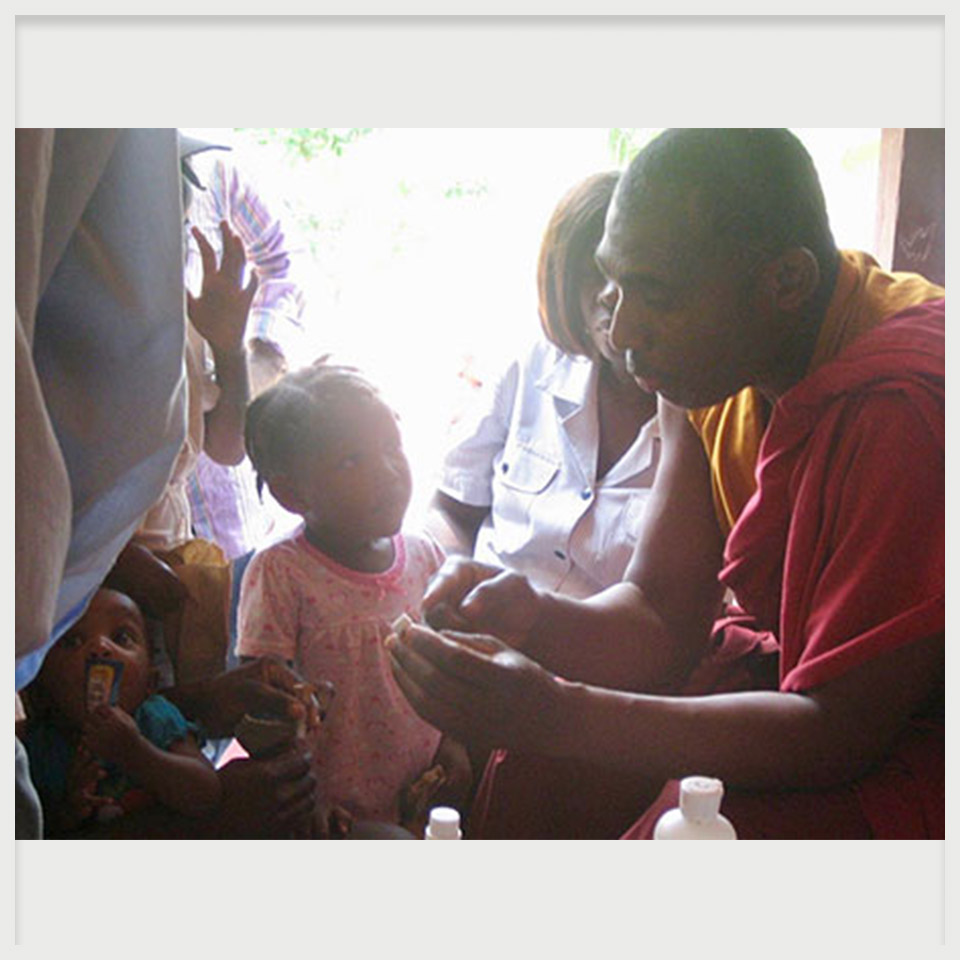
V: Do you have cases that stand out that you’d like to share?
J: One of our cases that I love to talk about is that of a 2-month-old baby boy who was brought in to us who had been declared to be dying of yellow fever. He had been born to a 15 year old teenage mother and the bonesetter explained to us that girls like that will not bond with their baby if they see that the baby is sick, as a protection mechanism they then drop the baby, they emotionally disengage, because they want to save themselves the heartbreak from having their firstborn die. The mother had literally wandered off doing other things and left the baby in the tent camp and the warden of the camp, Marie-Lucie who is now working for the clinic, brought in the baby for treatment. She explained that the baby is dying, that the family had scraped together their last bit of money to bring him to the hospital, that the doctor diagnosed yellow fever and explained that it would cost a million so to speak for medical treatment, which they didn’t have. What happens in Haiti in such a situation is that the doctors will say ‘go on, take the baby home it will die.’
The baby was brought to us at that point and he seemed to be in a very dire condition, hanging limbs, the eyeballs turned up, and I was there with this very difficult situation, in a screaming environment with hundreds of people standing in line, tasked with being given 5 minutes to diagnose and heal a dying newborn. One of the things we use very much in the clinic as a diagnostic tool is Chinese pulse diagnosis because then you don’t need language. One of our questions for people coming to work at the clinic is: what do you know to diagnose without needing language, because you won’t be able to speak Creole or French, most likely. So, anyone doing Chinese medicine will know how hard it is to take a good pulse with a newborn. I used a technique where I took his pulse – you take the pulse with the fingertip of just one finger and it was extremely wiry, a very typical high fever/heat pulse, and I had by that time noticed that I could get really good pulse readings on newborn babies, because there were so many, by just putting the vial with the homeopathic remedy in their other hand. Because they have this reflex of holding onto everything, they just grab the vial. When I put the Aconite in his hand the pulse went down, the heat pulse signs were seriously going down. I gave him one dose of Aconite 200C, which is a very, very classical high fever remedy and within a very short time, something like a minute or two, his flapping hands came back up, the whole tonus came back to his body and – bing! – he opened his eyes. I gave the lady who had brought him a tiny bottle containing a few drops of lemon essential oil and asked that she do some sponge baths to help open his pores and to help cool his body.
We had also asked the bonesetter to come and see what he would say and he had a completely different approach. He felt the baby’s skull bones and he diagnosed his skull bones of being stuck from hard labour and he did something that we would consider a craniosacral adjustment of the skull and then he said the baby needed a paste of castor oil and ground nutmeg applied to the central fontanella, which is what we did. Marie-Lucie brought him back the next day and he was well on his way to recovery. I like to give that story because it is a wonderful example when it comes to situations of extreme healing, how we use the modalities and co-treat with our Western way and the Haitian way.
V: What is it like to see so many patients in a day? In the context that most herbalists are familiar with and work in we have this idea that when you see someone you need 2 hours, that there must be detailed case taking and analysis, and so on. What is it like when you don’t have nearly close to that amount of time and may not even be able to communicate with your patients through language?
J: First of all I want to put this into context. We figured out very fast that anybody who was too intellectual couldn’t function in such an environment as a healer. If you ask yourself too many questions you won’t be able to function there and you have to make a lot of tough decisions before you even begin. Such as: there are things you are not going to treat, we didn’t do shortsightedness, diabetes, caries, and advanced chronic disease – which is not so prevalent in the first place because the population we were working with, the poor people in the ghettos, is what I like to consider a virgin population by and large. They had never had pharmaceutical drugs, vaccinations, operations, or anything else – they were just people who had never been medically treated, and they respond marvelously. They have what I would just call for now more superficial acute diseases and they respond very, very well. We are here to do emergency medicine. That was our focus going in; it was simply not possible for us to focus on treating chronic diseases.
That’s already the shift you have to decide on when you go into a disaster situation, to say we are doing emergency medicine. Since then the clinic has evolved because we have been there for a long time now and we do work on things such as very big difficulties in pregnancy, handicapped children, diabetes, breast cancer and other things like that. But at that time we were doing emergency medicine exclusively. We individualize, but you can’t individualize too much. There is something that I knew from Chinese medicine, which is the art of getting to the point in 3 questions. I told everybody you have to perfect that. You have to very quickly have the three questions that eliminate everything down to 2 or 3 remedies – then differentiate between them and you’re there so that you can on average treat a person in 5 to 10 minutes. I had to see 150 people a day, I was so exhausted that I couldn’t function anymore and we had not by any estimation seen everyone in line. The line looked to be the same length at 7AM as it did late in the afternoon when we finished, because we couldn’t go on. The other thing is the environmental context, with this brutal, damp, tropical heat and you’re being eaten by mosquitos top to bottom the entire time you’re sitting there. So for Jinpa and me, what we did was we just allowed ourselves to be in some kind of a trance or autopilot state using intuition. This is not the kind of intuition where I’m intuiting something that I have never heard about or have no experience with. I’m talking about intuition that comes out of a lot of knowledge and experience. For me, it was actually a really nice experience to be in a situation where I can’t intellectually think; I don’t have the time, everyone around me is screaming, I’m scratching so much I’m close to fainting, we were very hungry, we couldn’t eat, it was very dirty, it was extremely unsafe to eat, we couldn’t eat until the whole work day was over, there was no water… It was beautiful to see that when you have to, you can operate like that as a healer; I believe you have to be trained though. I don’t know if that could work if you had no prior knowledge of working in such an environment.
 (Robinson takes Marie Lucie to treat a person struggling to breathe)
(Robinson takes Marie Lucie to treat a person struggling to breathe)
V: What can you tell us about the COVID situation in Haiti? You mentioned in the last newsletter that it doesn’t seem to be affecting the population very much at all. (As of May 27th, 2021)
J: COVID has done very little in Haiti up to now; they’ve started a large clinical trial to find out why that is the case. There are a lot of ideas that have not been verified, such as that there are very few enclosed spaces – the vast majority of the population essentially lives outdoors, the houses don’t have glass enclosing the windows and the doors are always open and wind is always blowing through the houses. Also, it has been discussed that half of the population is younger than 18, as well as other factors relating to Haiti being an underdeveloped country. From my own point of view, it is very well worth considering that they are so unspoiled by civilization in many ways, that the population tends not to suffer from deep chronic diseases. The kind of conditions that we are always pointing to as making a person vulnerable to COVID, don’t exist for the vast majority of people living in Haiti. This is a sugar producing country, even the poor kids do eat sugar, but they are so hungry so often in between that they do not have diabetes. No chance.
In the pre-COVID era, it was established basic epidemiology that you do not start to vaccinate while an epidemic is ongoing, because you’re essentially going to create mutation pressure on the virus. In this case, it is remarkable and frightening to me that now that vaccination has started in Haiti, although most people don’t want to get vaccinated as they are very suspicious against vaccinations, that now suddenly COVID is becoming a problem. There are rumors that now that the Brazilian variant has arrived it mostly hits the gut, so people get diarrhea like symptoms for 2 or 3 days and then are dead. I think it’s way too early to say much about it, so we are also right now quickly looking at how to adapt our protocol. Up to now we’ve had really amazing results [treating symptoms] just using essential oils of peppermint and eucalyptus, which are antiviral, antifebrile and bronchodilating, so I think peppermint is still a good idea for a virus affecting the gut, but we may have to rethink things. I’m just waiting to get past the rumor stage, so we can differentiate between what we are hearing about the symptom picture and what is actually going on. We need to get things substantiated, because the political situation is completely corrupt and malfunctioning at this point. People are not even sure that what is now being said about COVID in Haiti is not just a series of rumors that the government has put out in order to manipulate people in some way – the political situation has deteriorated to such an extent.
The rumor that suddenly there are COVID cases and people are dying from it, makes people not sure that this is not a way of scaring them into vaccination and whatnot… It is very hard to verify a lot of things in Haiti because there is no free press, there is no functioning government, it is a complete mess.
V: There seems to be a climate of distrust and suspicion that moves in many different directions.
J: Yes, and it is well justified and well founded distrust.
V: What can you tell us about traditional Haitian herbalism, and some traditional herbs that are commonly used?
J: Traditional Haitian herbalism is largely rooted in African herbal traditions. You find a lot of similar ways of thinking, similar medical understanding, as you would find in Africa. So for instance there’s the bonesetting aspect, which is very strong in African traditional healing systems, and it is practiced in a similar way with the patient just lying on a mat on the floor and the healer will use his or her feet to push the bones into place. Diagnosis very much has to do with looking at the state of the blood. There’s a strong emphasis on the evaluation of the state of the blood, and there’s some overlap with other traditional systems in this respect. They will think in terms of: is the blood good or bad, does the blood rise, is the blood curdling – when it is bad, the blood has a tendency to curdle. Is the blood curdling because of things the person ate and ingested or because the emotions are going overboard? You have this situation with a lot of heat and sweat and really explosive emotions. Many Haitians are very volatile emotionally and can get unbelievably angry, and in the those moments there is, for lack of a different word, a phenomena where the blood curdles and you can literally see it where there are stains under the light part of the skins on the palms of the hands. We might want to intellectualize and say there’s microscopic bleeding and thrombosis. That’s a big warning sign and they need to rush the patient to a clinic to have them treated immediately, otherwise they can die. We’ve needed to deal with that at the clinic also.
Our bonesetter and Jinpa grew up in the culture and gave us crash courses on this, because you would get patients who sit in front of you and they would say things like, ‘I have bad blood.’ Even when they say ‘I have anemia’ it means something different than what we understand by the word. We mean not enough red blood cells, whereas they basically mean not enough of whatever good thing there could be in the blood as a consequence of malnutrition. They may have enough red blood cells, but it really means I don’t have sufficient blood sugar, fats, proteins, and all the rest of what is essential to me – I’ve been hungry for a long time. It was very necessary for us to also understand the bases of Haitian herbal medicine to have a proper interface with the people who came to us speaking from that place of understanding.
V: Are there any particular herbs that you’d like to discuss which are widely used traditionally?
J: Haitian herbalism [and] Haitian culture is of course a mix which draws from the original native [Indigenous] people who lived on the island, then the African slaves who came from many different tribes and what would now be the modern countries of Africa, and the cultures of the Spanish and French conquistadores. It is very much a cultural melting pot, which is also reflected in the use of the most common herbs or medicinal plants in Haitian herbalism today. Many of them are plants that came with the conquistadores, or that were otherwise brought in; such as cacao (which would have been local), orange leaf, lemon, the citruses, peppermint, basil, cinnamon leaf – I even saw loosestrife – and chamomile flowers which are available in the stores. None of that we would expect when we ask the question about commonly used herbs in the Haitian tradition. I was frankly also surprised. There is, if you wish, a full integration of European style herbalism in popular culture and of course they also use the fruits and veggies that are around such as garlic, papaya, and things like that. Papaya for instance, because it is rich in digestive enzymes, is used as a poultice on wounds. The men also use papaya seeds – and this is really more traditional – because they have a jelly like cover; the papaya seeds, they look like sperm, and based on the doctrine of signatures/language of plants, the men eat the seeds in order to increase manliness. You also have Jamaican dogwood and you will find guys by the roadside with huge glass containers full of Jamaican dogwood soaked in local cheap rum. You can go to them to get your shot glass full for your virility, and things like that. Other examples that would really be more local is for instance the use of boiled guava leaf, which is astringing. The taste frankly reminds me a little bit of blackberry leaf tea, so they use it for diarrhea and also to astringe the guts. They have a kind of a plant which is a creeper with fleshy heart shaped leaves, a kind of liana – they call it in French, liane molle. The leaves are soft and can be cooked to a kind of spinach like consistency, and this is used as a blood builder, for anemia, but also as a demulcent.
Most notably for me is the use of nutmeg. We discussed the use of nutmeg in the clinic in our last newsletter, and I want to encourage people to sign up for the newsletter because we always include case histories and new aspects about healing plants. I try to make it an educational newsletter for people who are plant healers. Ground nutmeg is used very much in Haiti for paralysis type symptoms related to strokes. What is very interesting is that, as nutmeg is a strong remedy, those very types of symptoms will develop in someone if they overdose on it. We find ourselves back at the alchemical truth that a poison can, in a tiny amount, heal what it can produce as a symptom. That principal is the basis of homeopathy, of course [the homeopathic law of similars: Similia similibus curantur, “likes are cured by likes”]. Nutmeg under the Latin name Nux moschata is a homeopathic remedy that will cure all those very same symptoms so I thought it was very cool as a homeopath to see that the local herbalists use nutmeg powder, a pinch under the tongue, in exactly the same way we would use Nux moschata in the potentized fashion.
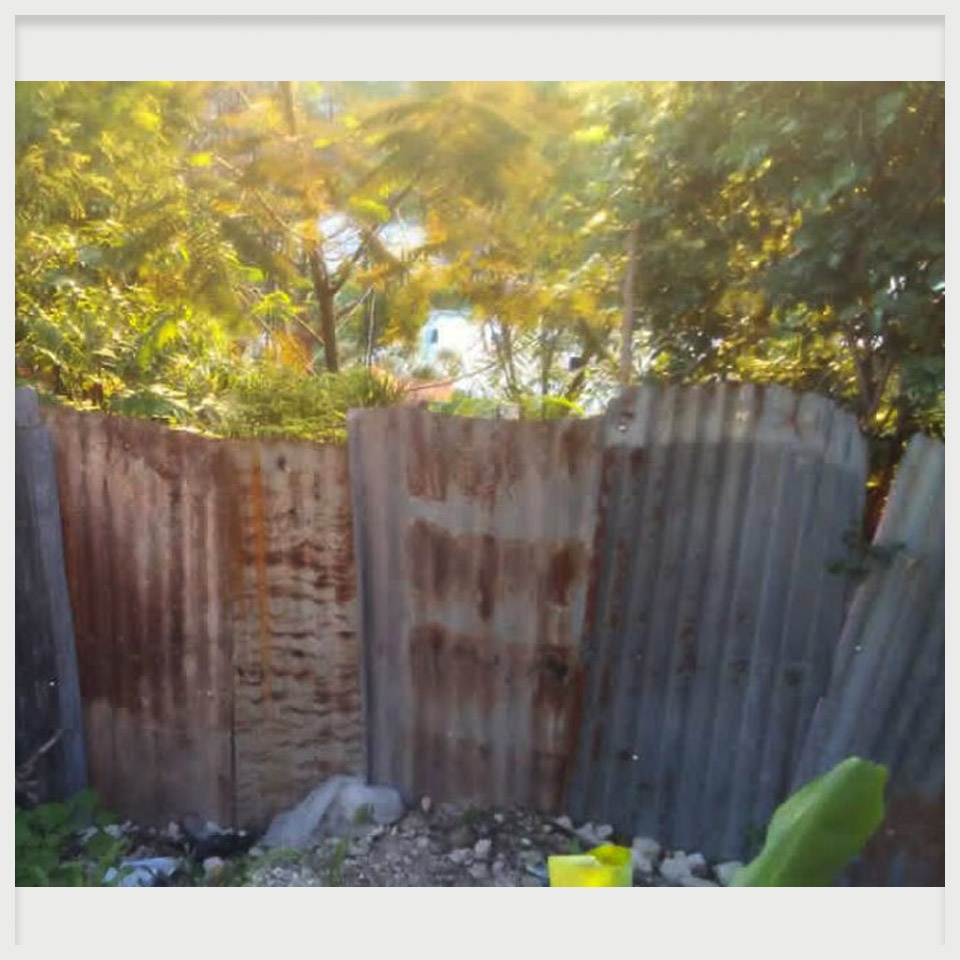
(The Herb Garden Enclosure)
V: Is there anything else you’d like to address? Are there ways that people can help through donations in any other way?
J: Our clinic has really only survived because people have always taken a real interest in our work and donated basically all of the medicines. All of the herbs, dried herbs, tinctures, homeopathics, essential oils – it’s all donated and people can send us an email through the website if they have a question about what we would like to be sent in terms of clinic supplies and where to send it. We ship things mostly from New York, but sometimes also from Europe. That is a huge help because none of us are paid. We are all volunteers. We collect cash to pay for the costs of shipping and everything goes straight to Haiti. We are trying to be the slimmest organization possible, one where no cent is lost. We do pay the people on the Haitian side because they have no other means of income – unemployment is probably between 80% and 90% in Haiti and we pay them $40USD a week, we don’t even know how they can survive on so little, so do not think that they can go out and buy themselves a mansion, they cannot. In fact, Marie-Lucie, now that we can’t run the clinic out of the usual location because of the COVID curfew, is running it out of her home which is kind of a shack. Just a couple of concrete blocks put together with a little bit of corrugated tin on top. Any donation of cash, or natural remedies is very, very welcome. Use your connections, see if you know somebody who owns a health food store, a distiller, other such companies. We take things that have been expired, sometimes we rebottle them or we take things that have reached their sell by date. Just contact us if you have a question and we would be so thrilled. This is truly the herbalist’s and aromatherapist’s clinic, it has been fueled really by their efforts and donations.
1 Readers interested in further exploring the science of homeopathy can refer to the award winning homeopathic medical research undertaken by Professor George Vithoulkas [here]
If you would like to check out more information about the Clinic or learn more about how you can help, please visit www.haitinaturalclinic.org
Wild Blueberries and Memories of My Dad
Wild Blueberries and Memories of My Dad
Wild blueberry season has begun, and when I think about wild blueberries, I think of my Dad. A true blue noser from Joggins, Nova Scotia – a province known for wild blueberries. I was fortunate to get to spend time with him before he passed in his childhood home doing all the things one would do in the little Bay of Fundy village… Visiting the fossil cliffs, clamming and picking wild blueberries. Now my Dad was never one to do things the conventional way, so off he goes to gather berries with a homemade tool that looked like a pair of salad tongs. Hours later he returns, grinning with his two full pails and a story about a bear he befriended along the way. In our little cabin not exactly equipped for baking, he announces that we should make blueberry pies so I run out and borrow a rolling pin from a neighbour. All goes well until I find a mushy mess in his pails from his make shift gathering tool. I say to Dad, “your berries are squashed” and he says, “no problem, I’ll make blueberry juice!” And he does!
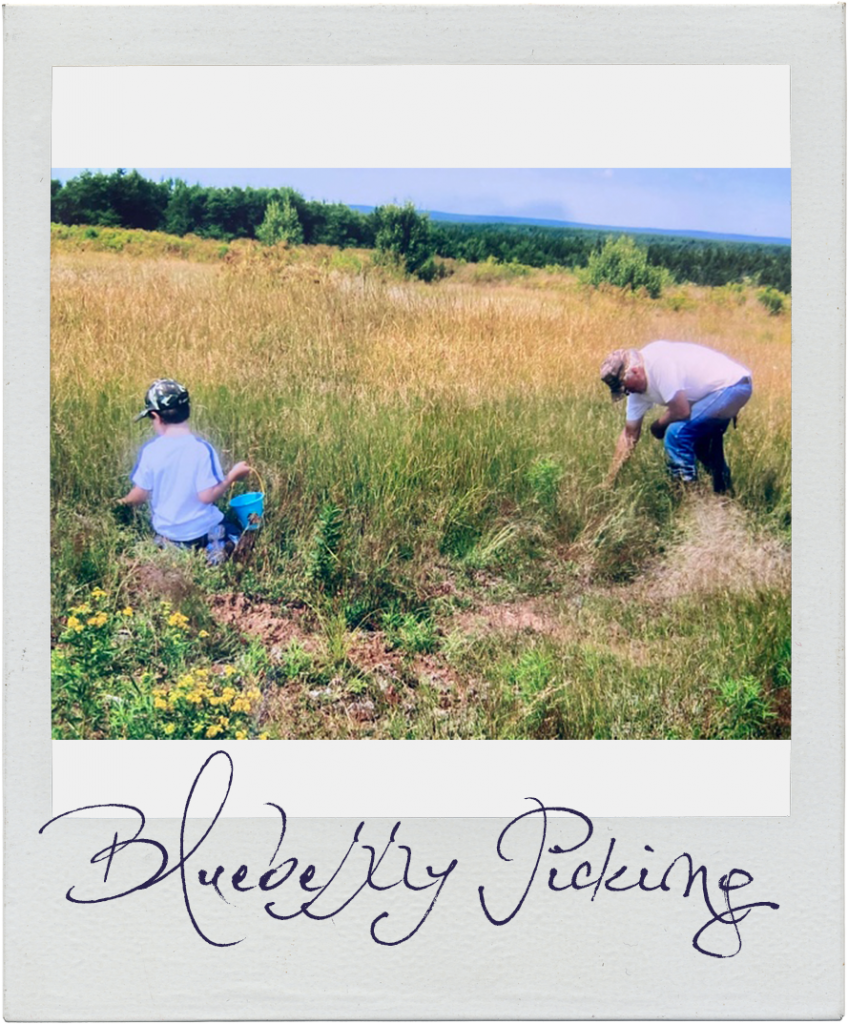 (My dad, Wayne Hoeg, picking blueberries in 2007 with his grandchildren, Hayley and Dallas)
(My dad, Wayne Hoeg, picking blueberries in 2007 with his grandchildren, Hayley and Dallas)
The next day more adventure ensue as we head out with the kids and the dog all suited up in our rubber boots to go clamming further down the bay. We come back later that evening, muddy with the same two pails only this time full of clams. Into the pot they go and we have a late night clam supper while my Dad pours an ice cold beer into a tall glass and tops it off with his blueberry juice and I have to try what he calls a “blueberry beer”… I don’t know if it was just the fresh salt air and the hard afternoon of trudging through the mud digging clams, but a fresh clam boil with blueberry beer and blueberry pie for dessert was a taste experience I will never forget, and a memory of my Dad I will always cherish.
That was an experience I can’t get here in Ontario, but I always have frozen wild blueberries in my freezer and they go in my smoothie every day – not only because I love them, but because they are so awesome for your health. Wild blueberries have a flavonoid called anthocyanin that is a potent antioxidant responsible for the beautiful, deep, bluish-purple colour in the skin. Antioxidants fight free radicals that cause diseases in the body such as heart disease and cancer, so I personally consider wild blueberries one of nature’s most powerful foods.
The Medicine of the Blueberry
Also, the wild blueberry plant is extremely resilient. It can boost your own resiliency and help you recover from crisis. Anthony William, the Medical Medium writes,
“Native Americans observed early on that when wildfire occurred, the only thing that would grow in its path afterwards were wild blueberry plants — in fact, they would come back stronger and healthier than ever before. This is the source of the wild blueberry’s power: not only can it rise from the ashes, it uses those ashes to its benefit.”
Wild blueberries support my physical and spiritual well-being and they will always provide me with beautiful memories of my Dad who I miss every single day… And as an Anishinaabe artist, I often enjoy capturing the spirit of blueberries in my paintings.
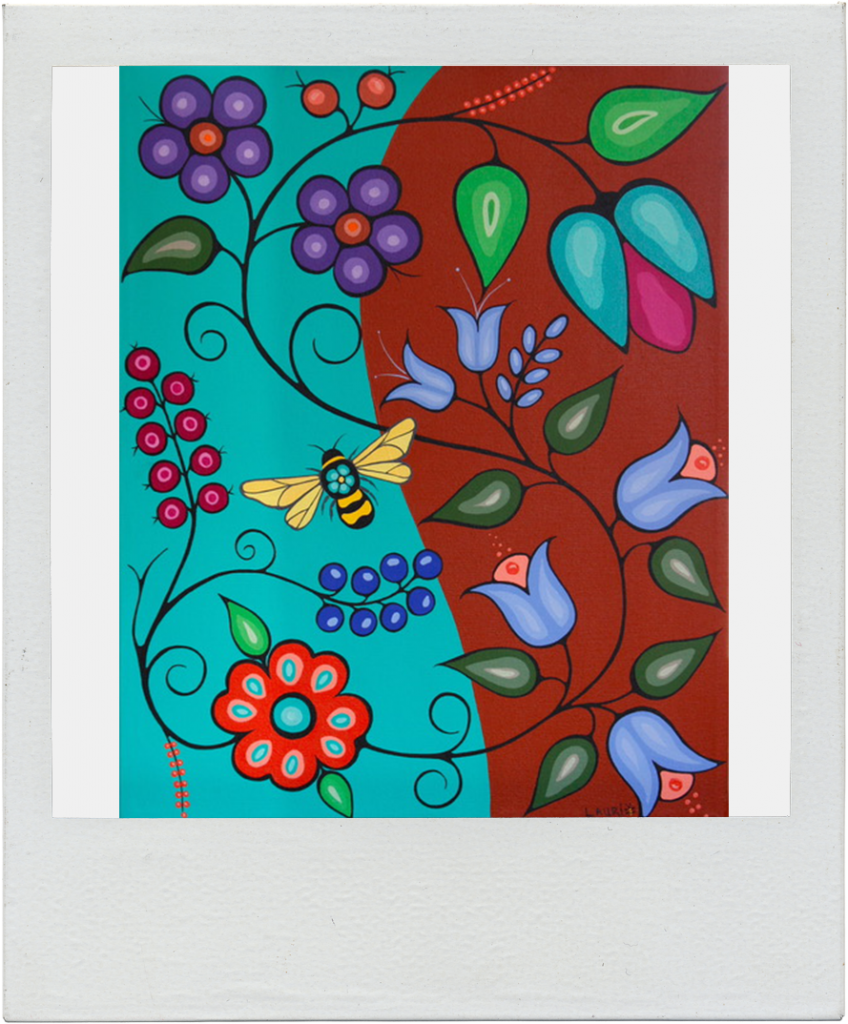
Blog “polaroid” photos and art provided by Lauri!
Herbal Actions: Astringents
Herbal Actions
What is a “herbal action”?
When we speak about the action(s) of a certain plant, we are referring to one or more effects a plant can have on our body. Often these actions are explained in two or three words; however, herbal actions are so much more than that! Since plants are wonderful complex beings, they also have several actions. Most herbs can compliment their action(s) in combination with another herb, basically showing off their best side with the support of a “good friend”. Sometimes they work great on their own, but most of the times, they excel with a good buddy on their side. Think- Teamwork!
Astringents
The Astringent feeling is something you probably can all relate with. If you are unsure, taking a bite out of any unripe fruit or vegetable will quickly remind you what it feels like. Rather swiftly, your mouth will dry out completely and leave you with a very puckering sensation. Another great example is that of black tea, especially one that has been steeping for too long. Why not make yourself a cup and consciously experience the sensation of astringent herbs? Take a sip and leave it in your mouth for about a minute or so. Can you feel how it has affected the mucosal lining, how the tissue has tightened and a very mild analgesic feel is overcoming the inside of your mouth? This is astringency.
Tannins
This dryness you experienced is the result of tannins, found in astringent plants. Tannins are a subcategory of phenolic compounds. Back in the day, tanning leather with astringent plants was very common practice. Animal skins were often preserved with Oak bark, Walnut shells and other specific tree barks. Nowadays, leather is mostly tanned with mineral salts and other inorganic substances. However, the term “tannin” comes from its traditional usage for tanning leather.
I always like to find out “why” a certain plant is high in a certain constituent.
Plants high in tannins (often found in the bark, roots and also leaves) protect themselves internally from different kinds of funguses as well as protection from mold; they are helpful for the plant to prevent water, bacteria or other pests to enter. Externally they serve as protection from loss of fluid from the plant itself. Aren’t plants amazing??
How Astringents Work
Traditionally, astringents are used to treat tissue states.
Herbalist David Hoffmann writes that tannins have a lot of benefits, including:
- Reducing irritation on the surface of tissues through a sort of numbing action
- Reducing surface inflammation
- Creating a barrier against infection, which is of great help for wounds and burns
Astringency also dries up extra moisture in the body. This can be helpful for a cold, wet gut or diarrhea.
Where the energetics are mostly plant specific, it can be said that astringents are cool and dry (with exceptions of course). Therefore, astringents are best suited for damp conditions.
Astringents and the Body
So, let’s get into how astringent herbs can be useful for our body.
By tightening the upper layer of the skin, tannins make it hard for germs to enter the body via the skin. In case of a bleeding wound, astringents can constrict blood vessels to help staunch it. In this case, we call the action styptic. Due to the astringent and mildly analgesic actions, astringents work great to soothe a sunburn or other mild burn.
Examples of Some Astringent Herbs
- Achillea millefolium (Yarrow), Arnica montana (Arnica) as well as Quercus spp. (Oak) are all great astringents for the skin.
- Rubus fructicosus (Blackberry) root seems to be well known for its high amounts of tannins and is a strong remedy for both diarrhea and dysentery.
Wonderful herbs for the digestive tract include:
- Rubus fructicosus (Blackberry)
- Filipendulum ulmaria (Meadowsweet)
- Salvia officinalis (Sage)
Astringent herbs are frequently used to address urinary incontinence, bedwetting, and are an important part of urinary tract infection treatments.
Specific herbs for the urinary tract include:
- Equisetum arvense (Horsetail),
- Achiella millefolium (Yarrow)
- Cyanococcus (Blueberry leaf).
If you have experienced pregnancy, chances are you drank lots and lots of Rubus ideaus (Raspberry leaf) tea. This nutritive astringent tonic is great to strengthen the uterus and get it in “top form” for delivery – and back into form, after delivery. Rubus ideaus is a wonderful herb for the reproductive system.
I hope this post gave you a little insight on Astringents and how they can interact with our body. This topic is covered much more in depth in the herbal course, which is currently developed and coming soon by our group of wonderful herbalists.
Resources:
Besides my own words, this write up features information from the following resources:
– Ursel Buehring Praxis- Lehrbuch Heilpflanzenkunde – Grundlagen – Anwendung – Therapie. 4 ueberarbeitete Auflage. Karl F. Haug Verlag in MVS Medizinverlage Stuttgart GmbH & Co. KG’ 70469 Stuttgart, Germany. 2014. (Published in German language)
– Jim McDonald – Foundational Herbcraft – www.herbcradft.org – collected writings from www.PlantHealkerMagazine.com.
– David Hoffmann – Medicinal Herbalism: The science and practice of herbal medicine. Healing Art Press, Rochester, Vermont 05767. 2003.
– Abrah Arneson – The Herbal Apprentice: Plant Medicine and the Human Being – Green Heart Press. 2014.
– Matthew Wood – The practice of Traditional Western Herbalism – Basic Doctrine, Energetics and Classification – North Atlantic Books, Berkley, California. 2004.
– Lisa Ganora – Herbal Constitiuents: Foundations of Phytochemistry – Herbalchem Press, Louisville, Colorado. 2009
A Friend in Red Clover
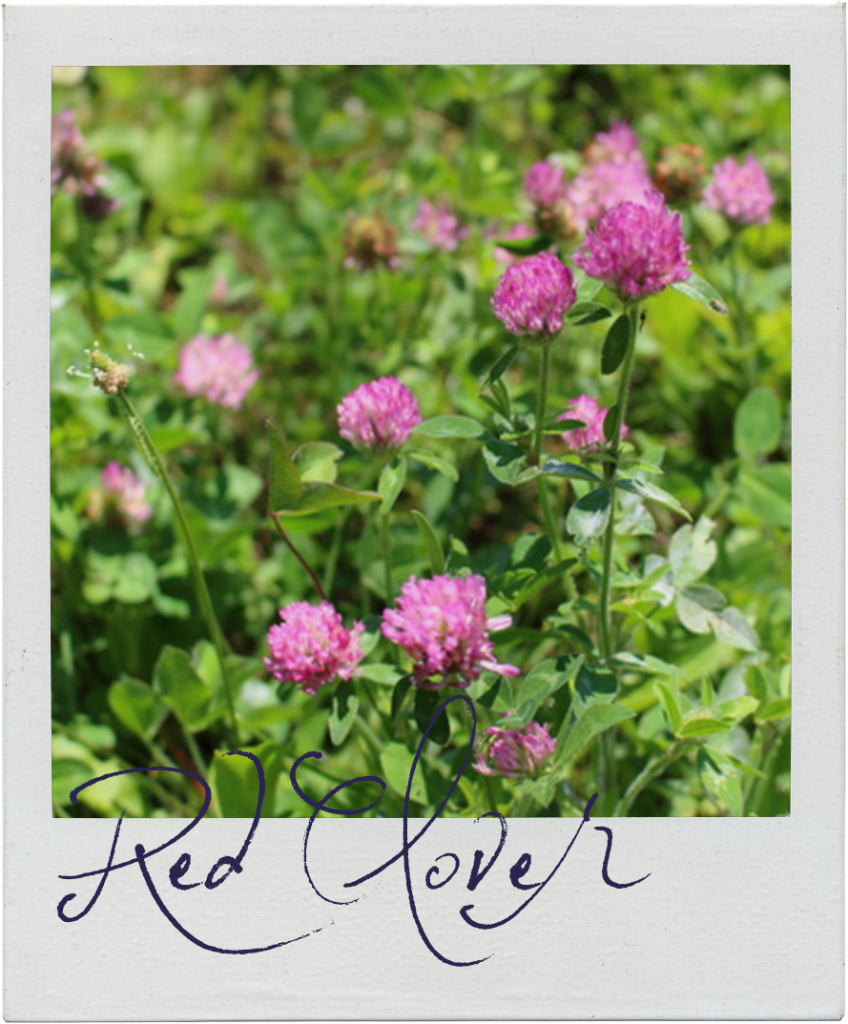
A Little Talk with Red Clover
Sometimes life throws you a curve ball and you are knocked to the ground with such force that you can only wonder, “what the hell just happened?”
This literally happened to me a few years back, on a beautiful summer day, playing a friendly game of baseball with my First Nation community. A mix of all ages and skill levels gathered for good fun. I was back catching when a teenage boy on short with a powerful arm threw the ball home. I was in position, glove up, sun in my eyes, with no protective mask on, when I heard a crack and fell to the ground. I ended up with several fractures in my left cheek bone.
Many weeks of healing ensued and I think back to the helpers along the healing journey, especially the plants. Arnica, Solomon’s Seal and especially Red Clover. My friend Penelope teaches an old folk saying about Solomon’s Seal; “for a willful woman stumbling on her hasty husband’s fists!” My injury was a blow to the face, so Solomon’s Seal seemed just the thing – and there was Arnica for the pain. Now, Red Clover does not seem the obvious go-to herb for this issue, but this pretty herb came to my soul’s rescue.
A few days after the accident, I left my bed for a walk to feel the warm summer breeze on my swollen face and hear the birds sing to cheer me. I walked right into a patch of thick Red Clover so beautiful it stopped me. The leaves were speckled with white and the plump pink flowers were buzzing with bee activity. I gathered some blossoms and headed home to fill the kettle. The cup of Red Clover tea soothed my soul and my nerves, and I continued to visit that clover patch through my weeks of healing. Red Clover is an alterative, sedative, deobstruent, and for me… a friend when I needed it most.
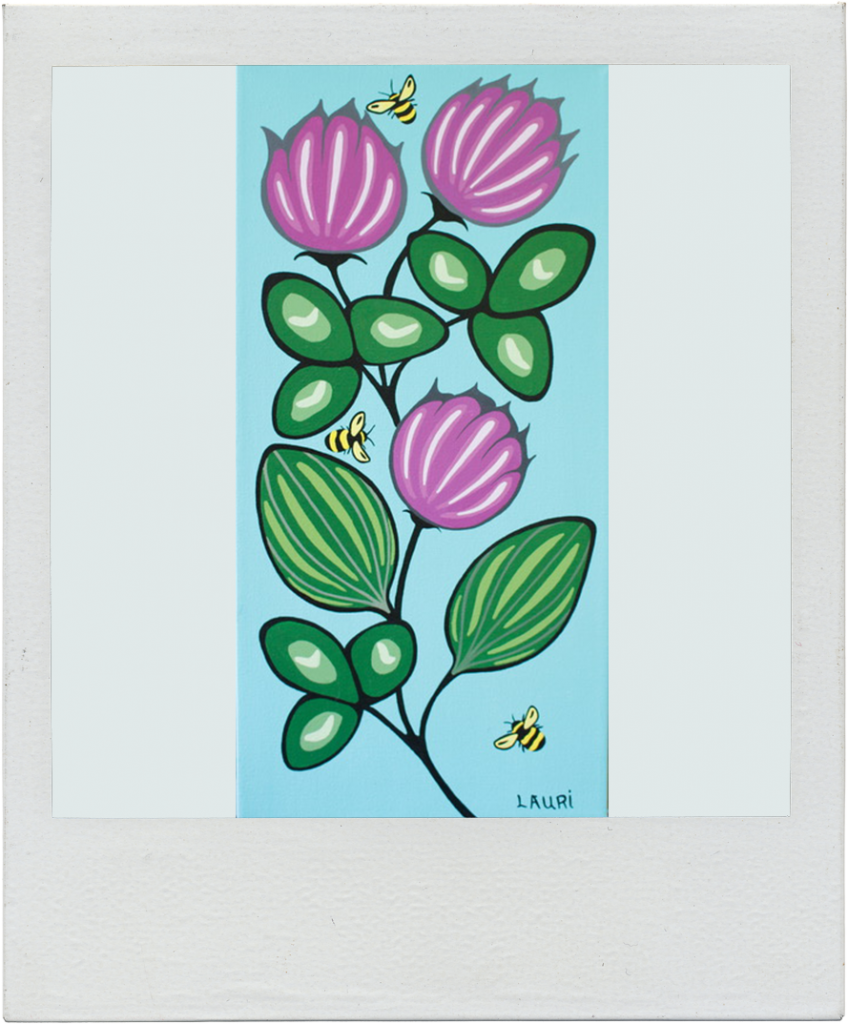
Blog “polaroid” photos and art provided by Lauri!



